#this was because my professor showed a gallery photo of an artists exhibition
Text
was told by my seminar professor that i could be an art critic and it was like my purpose in life was presented to me
#this is an exaggeration#kind of#but seriously i never considered art criticism as a career?#i mean its probably mot a lucrative one considering#but like THE POSSIBILITIES??#i never considered it#i love critiquing art#i love being a hater and occaisonally a lover#this was because my professor showed a gallery photo of an artists exhibition#and i was like this is so unsettling not bc of the paintings but bc of the EMPTINESS of the room#but it was literally a dark grey floor white walls and four paintings as a set on ine wall#and another painting on another but the gaps between each piece was horrendously large and the entire room was utterly devoid of furniture#and it was so unsettling and the paintings by themselves were already weird so the empty room made it worse#but anyways he made the art critic comment bc i said something like#the room is even more unsettling bc of the (sorry) 'weird ass pictures'#and apprently that was a really vivid description lmao??#but anyways i have much to think abt.....#i would love to make it my job to just go to exhibitions and critique them#its my favorite thing to do#i would be like that food critic guy in ratatouille#hater abt everything except the Rat Made Food#michi tag
0 notes
Text
Artist Research - Barbara Kruger

Life -
Barbara Kruger was born in 1945 in Newark, New Jersey. Kruger briefly attended Syracuse University, then Parsons School of Design in New York City, where she studied with artists and photographers Marvin Israel and Diane Arbus. Kruger worked in graphic design for Condé Nast Publications at Mademoiselle magazine, and was promoted to head designer within a year, at the age of twenty-two. Kruger has described her time in graphic design as “the biggest influence on my work…[it] became, with a few adjustments, my ‘work’ as an artist.”
At the beginning of her art career, Kruger reportedly felt intimidated by entering New York galleries due to the prevailing atmosphere of the art scene which, to her, did not welcome "particularly independent, non-masochistic women". However, she received early support for her projects from groups such as the Public Art Fund, which encouraged her to continue making art.[16] She switched to her modern practice of collage in the early 1980s.
Kruger lives and works in New York and Los Angeles. She is an Emerita Distinguished Professor of New Genres at the UCLA School of the Arts and Architecture. In 2021, Kruger was included in Time magazine's annual list of the 100 Most Influential People.
Kruger taught at the University of California’s Berkeley, San Diego, and Los Angeles campuses. Solo exhibitions of her work were organized by the Institute of Contemporary Arts (1983), London; the Museum of Contemporary Art (1999), Los Angeles; the Moderna Museet (2008), Stockholm; the National Gallery of Art (2016), Washington, D.C.; and the Art Institute of Chicago (2021). She participated in the Venice Biennale in 1982 and 2005 and received the Leone d’Oro for lifetime achievement at the latter. Kruger’s work appears in the permanent collections of several major museums, including the Whitney Museum of American Art and the Museum of Modern Art, both in New York City.
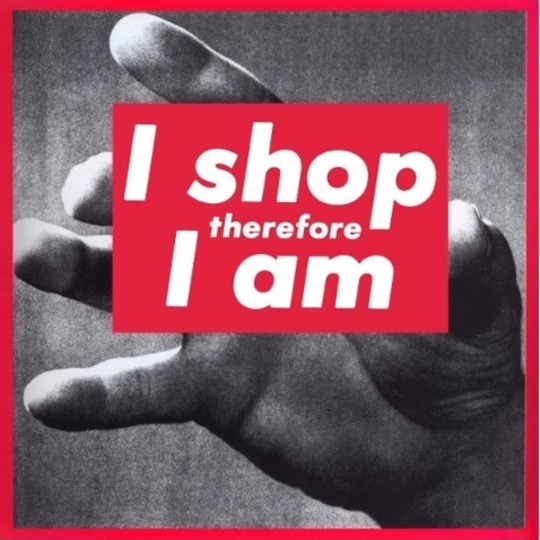
Work -
In the early 1970s, Kruger started showing artwork in galleries in New York. At the time, she was mainly working in weaving and painting. However, she felt that her artwork lacked meaning, and in 1976, she quit creating art entirely for a year. She took a series of teaching positions, including at University of California, Berkeley. When she began making art again in 1977, she had moved away from her earlier style into photo and text collages. In 1979, Kruger developed her signature style using large-scale black-and-white images overlaid with text. She repurposed found images, juxtaposing them with short, pithy phrases printed in Futura Bold or Helvetica Extra Bold typeface in black, white, or red text bars. In addition to creating text and photographic works, Kruger has produced video and audio works, written criticism, taught classes, curated exhibitions, designed products, such as T-shirts and mugs, and developed public projects, such as billboards, bus wraps, and architectural interventions.
Kruger addresses media and politics in their native tongue: sensational, authoritative, and direct. Personal pronouns like “you” and “I” are staples of Kruger’s practice, bringing the viewer into each piece. “Direct address has motored my work from the very beginning,” Kruger said. “I like it because it cuts through the grease.” Kruger’s work prompts us to interrogate our own positions; in the artist’s words, “to question and change the systems that contain us.” She demands that we consider how our identities are formed within culture, through representation in language and image.
While Kruger often produced her work on vinyl, she also made everyday objects and increasingly large-scale installations. In 1990 her work Untitled (I Shop Therefore I Am) (1987) appeared on shopping bags, while Untitled (Questions), a three-story mural resembling the U.S. flag, was installed at the Museum of Contemporary Art, Los Angeles (later the Geffen Contemporary at MOCA). The mural featured nine questions, including “Who is beyond the law?,” “Who does the time?,” and “Who salutes the longest?” The provocative yet abstract questions remained relevant when the mural was reinstalled in 2018–20 as the United States reckoned with protests over racial injustice and heightened political divisions.
0 notes
Text
Lucien: Art Gallery Date [Translation]

Translations under the cut!
This date contains spoilers for S2 of MLQC!
To explain some parts of this date: In S2, Lucien works in the Special Task Force as a consultant / former Black Swan member while MC is a part of Black Swan.
[Section One]

When we arrived back in downtown, it was already late into the night.
I stepped into the bright, white lights of the lift. Leaning against the wall, I let out an exhausted sigh.
“So tired..”
Due to a recent project in the company, I’ve been overworking and staying back for weeks, I’ve even spent a few nights in my office. However, it’s finally came to an end. The lift came to a stop on my floor, and ‘dinged!’ open.
As I stepped out of the lift, I was stunned.
“..Lucien?”
The lights of the corridor were quietly garish, showing me the awfully familiar silhouette at the end of the corridor. Lucien was leaning against the corridor, a book in his hands. As he heard the noises, he looked up towards me.
Upon seeing him, the lethargic bug in me instantly scrambled away to the back of my brain
.“Are you waiting for me?”
“Mmhm.”
“You seem busy these days, always coming back in this hour.”
“Has work been troubling you? I wonder if you need the help of this certain show consultant.”
His questioning in the once soundless hall had a lace of care in them.
“There aren’t any problems, just a new project. It’s almost at its end.”
“Since it is coming to an end, how about this weekend, you stay for me?”
His eyes were soft along with his smile, as if he knew I will never say no.
“Not this weekend.”
His smile’s died down for a fleeting moment, and he looked at me puzzled.
“I have a project meeting with our collaborators this weekend, we have to discuss the last bits of the project.”
“So sorry, but I can’t accept your invite.”
I gave Lucien an apologetic look. Surprisingly, he didn’t say anything. Instead, he nodded understandingly.
“I see.” He turned around to open the door, and walked into his apartment.
“....”
I quickly stepped towards the door, and used my hand to block the door from closing. Lucien’s gaze shifted from my hand to my face, his eyes held a certain deepness to them.
“Stopping at a neighbour’s door in the middle of the night, this action usually hides a certain warmth to it, does it not?”
“I just want to tell you, that I’ve been busy these days, but I’ll be free in a while.”
Lucien held the door open, and a moment later, his lips spilled a hint of a grin.
“Since you’ll have to work during the weekends, you must sleep well tonight, no?”
His speech was gentle, and in the silent night, it spun circles and landed onto my heart. I looked up at him, and gave him a smile.
“Alright.”
(Time-skip to the weekend)

The next morning, I held the ticket in my hands tightly as I stepped in front of the artistic building on front of me, noticing the signboard on the entrance before I enter.
“Sculpture Art Exhibition..”
“..This is the first time I’ve met with someone who’d insisted on meeting up in an art gallery.. Maybe they’re someone who’s passionate with art?”
Upon entering the gallery hall, I asked for the person’s location, and found the man in a suit not far away.
“Hello sir, are you the consultant for Nagaya’s Film Studio?”
“Hello, I’m the consultant, yes,”
He said as he handed me his name card.
“We’ve been in contact digitally, I’ve actually been looking forward to meeting you for quite some time now.”
I shook his hand as a form of politeness,
“I’m very honoured to be working with your company as well. The problematic areas have all been solved previously, so here’s to hoping that we can finish the last bits of the project by today.”
I took out the folders from my bag, but he said nothing.
“Is this location not to your satisfaction? The Art Gallery has a rich atmosphere; it’s quiet, and we can enjoy the works while having a chat.”
“It is pretty good..”
“Sir, please look at this section,”
I opened the file, passed it to the man, and attempted to shift the conversation to the right track. But he wasn’t in a rush to go through the files, and he smiled instead.
“Miss MC, no rush at all. Please take your time to stroll around, the files can wait.”
“But let us talk about the collaboration first..”
Before I’ve finished speaking, I was already speechless.
Past the crowded room, an ever-so-familiar figure walked past the glass door. Lucien gave the staff a polite smile as he took the directory map, and walked inside. Maybe it was because of my blazing stare, but Lucien looked up, and looked towards my direction.
And as our eyes met, his eyes curved along with his relaxed smile.
[Section Two]

“Miss MC?”
The collaborator tried calling my name, and as I came back to my senses, I apologetically smiled at him.
“Sorry, I’ve lost my focus just now.”
“Sir, this current project is very important to both parties, so let’s go through it together, and other things can wait. What do you think?”
I gave a determined look as I passed him the files, and he couldn’t do anything but accept them.
“There are generally no problems now. I’ll be signing it when I go back. Should we go tour the exhibition now?”
I unconsciously stepped half a step back.
“I’m very sorry, but I’ll have to pass the final version of this to my colleagues, so I might not be able to enjoy the exhibition with you today.”
My eyes darted to the side, but Lucien wasn’t there anymore. The man in front of me gave out a disappointed “oh,” but quickly started speaking once more.
“Since we’re already here, let’s take a few photos in the photo-taking area.”
“..Let’s not.”
I looked around once more, wanting to find Lucien, and yet I couldn’t see him anymore.
“That man over there, mind if you help us take a picture?”
“Sure.”
Lucien’s voice rang behind me, I turned around. He stood by not far away, his gaze landing onto me.
“....”
“Then I hope it won’t be a bother for you, sir..”
“-Oh, Professor Lucien? Can’t believe you’ll be here for the exhibition as well! What a coincidence.”
I cut through the collaborator’s words, pretend to look at Lucien with surprise, and hurriedly tried to wink, hinting at him to not help him. Lucien, however, said nothing and looked at me amused, his smile growing wide.
“Yes, a coincidence indeed.”
“You know each other? That’s great.”
He excitedly handed his phone to Lucien and stood by me as he posed like your standard tourist. I looked at Lucien, forcing a crooked smile out of me. Lucien amusedly held the phone, and clicked the photo-capturing button.
As soon as the picture was taken, I quickly stepped one step away.
The collaborator took the phone from Lucien, his eyebrows furrowing as he let out a puzzled noise.
“Eh? Why does this s picture only showed the sculpture behind us?”
“Although we can freely take picture of whatever that pleases us here, I believe the art itself is more worthy of the attention.”
The collaborator was stunned at Lucien’s words. Lucien turned around to look at me, and it’s almost as if it wasn’t there, but his eyes were almost as if he’s trying to tell me that he’s feeling guilty.
“MC, I’ve reminded you last night to take a good rest, why do you still seem so lethargic today?”
“Ah?”
He held out his hand, his slim finger coming to the dark circles under my eyes, and he rubbed it gently.
“Why are you always not taking care of yourself, making me worry?”
I was absolutely stunned frozen by Lucien’s sweet gestures and the collaborator’s shocked look in his face. After gaining my consciousness once more, I tried to step back, but was pulled back by him.
He sighed lightly, held my hand, and looked at the collaborator beside me.
“Sorry to have ridiculed you.”
“As you’ve seen, she’s been spending too much of her time and effort in this project. So much so that I can only “bump into her” here.”
“However, since the project’s come to an end, for the rest of this, would you mind giving her back to me?”
The collaborator’s stare landed on our intertwining hands, and a moment later, he face became rather awkward.
“Um, of course. I’ll send over the files right after I’ve signed them. Miss MC, it’s been an honour collaborating with you, I’ll take my leave now.”
After waiting for the collaborator to disappear, Lucien let go of my hand.
“That – thanks for getting me out of that..”
“So the work you’ve mentioned, is to actually come to the gallery with someone else..”
He looked at me, his words calm and collected.
“This is the meeting location, I couldn’t possibly reject them..”
I tried to explain, but Lucien’s gaze remained unfazed, and so I could only try to change the topic.
“Why did you come here? The exhibition today isn’t exactly popular.”
“Well-known or not, it isn’t a reliable factor to determine the value of things, is it not?”
“But are you truly here for the exhibition? This is too much of a coincidence..”
“I’m afraid I’ll have to disappoint you, but I’m truly here for the exhibition.”
I sent a suspicious look towards Lucien, and he looked at me once more.
“However, you said you still have certain things to address in your company. Are you not going to handle them?”
He smiled gently as he reminded me, his tone light and slow.
My heart skipped a beat, and it felt kind of strange. Lucien was almost like he was trying to push me away, but why was that so? I felt an unsettling feeling setting roots in my heart, so I tried to say it.
“I was just looking for an excuse just now. I don’t have anything else to do later, so since we’ve bumped into each other, why not tour the exhibition together?”
Lucien did not look at me, and instead pulled open the directory map, his eyes casted down as he focused on the landmarks marked on the map.
“You wishing to be with me, are those words truthful, or just an excuse t search for some kinds of information on me?”
I was wordless by then, and, following his gaze towards the map, I instead noticed the insignia of STF hidden and held tightly in the tips of his fingers.
“What about you? You said you’re here for the exhibition, were those words actually true, or was it an excuse to not make me feel suspicious?”
I looked at Lucien, and his dark-coloured eyes spun a circle around me.
“Seems like you’ve already found your answer. So a confession or not, it doesn’t seem to matter much.”
“But I wonder what happened, to have made you come and deal with it?”
Lucien tucked the map away, looking at me with interest.
“If I’ve already answered your suspicions, for me, is there truly an advantage?”
He asked sternly, as if he did not want to easily reveal the true reason why he’s there.
“If we share information on both parties now, I won’t be stingy with BS’ whereabouts the next time I get a hold of anything.”
Lucien’s smile widened just a little.
“Sounds good.”
[Section Three]
“Some sculptures in the Art Gallery have been used by a few Evolvers to trade illegal information.. I’ve heard that if we can find the point of trading between these people, it’ll benefit the both of us.”
Lucien gave a nod, and bent down slightly to whisper into my ear, making me flustered.
He chuckled lightly, and said-
“Then I’ll have to trouble Miss Nox to search through the gallery with me.”
In the soft rays of light and its brightness, and between the statues of exaggerated expressions and their less dramatic counterparts, Lucien’s steady breathing enveloped me, and I find myself wanting to hold onto this fleeting moment.
The colours of the sky gradually became darker, and we’ve almost I sorted every single sculpture in the exhibition, but have found nothing at all.
“Is it possible that they’ve already destroyed all the evidence?”
Lucien did not answer my question, and so I couldn’t help but to look at him.

In the pure white of the sculptures, he stood in the corners of their shadows, his eyes casted downwards as he observed the statue, intricately protected on its stand. The lines of the statues were sculpted with a sense of profoundness, and with Lucien standing quietly by its side, it’s like a serene painting.
I stopped myself from walking further, captured by the sight in front of me.
It reminded me of the many times I’ve turned to look back in the past, and how I can still always feel the touch of his gentle gaze.
“Are you looking at me?”
Noticing it, he turned to look at me. Though I still cannot truly tell the emotions swimming in his eyes each time he smiles, I’ve gotten used to smiling back in return.
“Yep, I was looking at you.”
I admitted truthfully, and turned by focus back to Lucien. A dash of surprise swam past his eyes, and then they quieted away into a languid silence.
“Then can you tell me what you’ve seen?”
“Mm.. I see a general show consultant lazing around, not seriously looking for any clues at all.”
Lucien smiled.
“If that’s so, then it seems like I’ll have to work a little harder.”
“You called me just now, did you find anything?”
I nodded, opening my mouth hesitantly.
“I’m wondering if there are already people changing the locations of the clues you’ve been searching for.”
“Perhaps.”
He didn’t seem surprised, his gaze still focused on the statue.
“Is there anything special about this statue?”
“There isn’t.”
His voice was prosaic, as if he hadn’t been staring at the statue a while ago.
“The sculptor’s skills isn’t as polished, and the facial expression is a bit unnatural as well.”
“Then why are you so drawn to it?”
“Haven’t you noticed?”
“This statue is the most well-protected in all of the exhibition. Compared to the occasional scratches and damages appearing in the other ones, this statue looks as if it’s just been made.”
Lucien’s eyes scanned through the carefully-protected statue, his gaze brimmed with complexity.
“Seems like its owner didn’t have the heart to let it endure even the slightest bit of harm at all.”
“It’s natural, isn’t it?”
I looked at the sculpture in it’s perfect condition, and I almost felt the love it’s received from its owner.
“To have thrown so much of their time and effort into this piece, they can’t help but to protect it with their all.”
Lucien shook his head.
“I don’t think so.”
“If it’s only for the sake of protection, the sculpture is, in the end, still just a typical novice-level sculpture.”
“Only with the sculpture enduring the test of time and its surrounding environment, can it truly become what one may call a masterpiece.”
His voice was low, with a hint of softness, as if he was talking about the sculpture, and something else as well.
[Section Four]
Evening arrived, and Lucien and I have unconsciously spent the whole afternoon in the art exhibition.
“We didn’t find any clues, not even any suspicious looking places. Lucien, why do you think this is so?”
I tried to piece together the puzzle in front of my eyes, but when my eyes met with Lucien, I suddenly realised one thing.
From the beginning till the very end, it was me who was trying to find the clues Lucien said there would be. And Lucien was the one who was relaxingly enjoying the statues one by one.
“As you’ve said, perhaps there are already people here before us.”
He seemed to not care about the results at all, his tone languid.
In my heart appeared a thought that was quite far-fetched.
To prove my theory, I walked to the side of a sculpture, pretending to search it thoroughly. Then, I quietly gestured Lucien to come over.
“Lucien, come, I think I’ve found a clue!”
“Is that so?”
I held some papers in my chest, pretending they were the information discovered, and looked at Lucien for his response. He slowly walked towards me, looking at the sculpture beside me.
“Do you know?”
“In my eyes, your actions are easily readable.”
Lucien leaned towards me, trapping me between the sculpture, and him.
“Eh? What are you doing?!”
Lucien looked at me directly, paused, and let out a light sigh. He took out the documents I held in my hands.
“Not bad. Indeed, there were no clues at all.”
“I was just trying to find an excuse, to spend an undisturbed afternoon with you.”
The crowds have lessened significantly in the exhibition hall, the motion-sensoring lights dimming out due to the lack of visitors.
The back of Lucien was a blurry darkness, which creeped to the sides of his trench coat, making him appear to be both lonely, and dangerous.
But he looked at me silently, as if he wanted me to hold his hand, and pull him to stand right by me. I thought back to when he pretended to be serious as he discussed of the happenings, and then fooling me into touring the entire exhibition hall with him.
“Lucien, you’ve ran in such a big circle, just because you want me to spend time with you?”
“Can’t I?”
His tone was plain and light, yet he added a bit of exaggerations in some of the syllabi.
“You seem to be very busy lately. So busy that you do not have the time to share a cup of tea with me, speak with me.”
His voice seemed to be laced with a hint of remorse, his eyes downcast as he looked at me.
For a moment, I was stunned wordless.
Because we did not move for a long while, the motion detecting light above is clicked off and away as well. And in the darkness, Lucien chuckled lightly.
“Looks like it’s already the closing hour. It’s time to end this tour now.”
Outside of the art gallery was a sinking twilight.
I followed Lucien along the sunset-bathed roads, and hesitated for a moment. I quickly walked to his side, and reached out my hand to the hem of his jacket.
Lucien halted his steps, and turned to look at me a little surprised.
“I remember the Special Task Force’s secretive research department do not have to have overtime for the weekends, and coincidentally, I’m free next weekend.”
I gave him a smile,
“So, Professor Lucien, can you borrow me your time next week?”
Lucien looked at me gently, and smiled. His voice and the surrounding clutter of other noises as clear as crystal in my ears,
“Of course.”
[END]
39 notes
·
View notes
Text
MLQC CN Lucien (Xu Mo) Art Gallery Date Part 1 & 2
SPOILERS AHEAD!!
It's Xu Mo Date which has released on CN server. I'm doing translation for personal reason, so I'm sorry if there's some mistranslation. Kindly tell me if you found some :) feel free for read it~ ^^
Part.1
When I returned to the community, the night was already very deep.
I walked into the elevator under the cold white light from the lamp, leaned against the wall wearily, and exhaled a long breath.
MC: So tired...
Recently, because of a cooperation, I have been working for several weeks in a row, and even slept directly at the company for a few days, but fortunately, only finishing work is left.
The elevator rose slowly, and finally stopped on my floor, "Ding" the door opened.
I stopped when I stepped out of the elevator door.
MC: Xu Mo?
The lights in the corridor were bright and silent, reflecting the very familiar figure at the end.
Xu Mo was quietly leaning against the corridor holding a book, and after hearing the movement, he looked up at me.
Touching his gaze, my sleepworm ran behind my head immediately.
MC: Are you waiting for me?
Xu Mo: Yes
Xu Mo: You seem to be very busy lately, always come back at this time.
Xu Mo: Is there a problem at work?
Xu Mo: I don’t know if you need a help from me as program consultant.
His inquiries were scattered in the silent corridor, with seemingly careless concerns.
MC: I did not encounter any difficulties. There is a new cooperation, which is almost over.
Xu Mo: Now that it's almost over, can you leave it to me this weekend?
The smile in his eyes is soft, it seems that I will not refuse.
MC: Not this weekend.
The smile paused for a moment, then looked down at me deeply.
MC: This weekend, I have made an appointment with the partner of this project to discuss the final conclusion together.
MC: So sorry, I cannot accept your offer.
I raised my eyes and looked at Xu Mo a little sorry.
Unexpectedly, he didn't say anything, and even nodded his head with understanding.
Xu Mo: It turned out to be so.
He turned around, opened the door, and walked in by himself.
MC: ....
I stepped forward subconsciously, and quickly blocked the door with my eyesight and hands when the door was about to close.
Xu Mo moved his gaze from my hand holding the doorknob to my face, his eyes darkened.
Xu Mo: Blocked at the door of a neighbor's house in the middle of the night, usually this behavior implies a kind of ambiguity.
MC: I just want to tell you that I have been busy recently, but I will be free in a while.
Xu Mo held the door handle, and after a while, a smile leaked from his lips.
Xu Mo: Since you still have to work on weekends, you need a good sleep tonight.
Xu Mo: Isn't it?
His tone was soft, and in the silent night, it fell on my heart in circles.
I looked at him and slowly raised a smile.
MC: Yes
--
In the morning of the weekend, I held the ticket in my hand and walked into the artistic building in front of me.
Special exhibition of sculpture art.
MC: ...This is the first time I have met someone who insists on discussing business cooperation in an art museum.
MC: Probably someone who loves art very much.
After entering the exhibition hall, relying on the location sent by the other party, I quickly found the man in the suit not far away
MC: Hello, are you Mr. Gu, the person in charge of Canggu Film and Television Company?
Mr. Gu: Hello, yes I am.
He said, handing over his business card.
Mr. Gu: I've been in contact online before. Actually, I've long wanted to see you.
I politely reached out and shook his hand.
MC: I am also honored to cooperate with your company
MC: We have made corrections to the areas where there were problems before, so we hope to finalize the final plan today.
As I spoke, I took out the documents I brought from my bag, but the other party did not answer the conversation.
Mr. Gu: Are you satisfied with the place I chose this time? The art gallery has a strong atmosphere and quiet. It is best for enjoying and chatting.
MC: It's pretty good...
MC: Mr. Gu, take a look at this place.
I opened the file and handed it to the other party, trying to get the topic on track, but he was not in a hurry to read the file, but smiled.
Mr. Gu: Miss, don't worry, let's go walk slowly. You can read the documents anytime.
MC: Let's talk about cooperation first...
The words are not finished yet, I was stunned.
Across the heavy shadows, A familiar figure is walking through the glass door
Xu Mo smiled and took a guidebook from the instructor and walked in.
Probably my gaze were too obvious. Xu Mo raised his head and glanced in my direction.
The moment his eyes met, he bent his eyes and smiled slowly.
Part.2
Mr. Gu: Miss?
The partner tentatively called my name. I recovered and nodded slightly to apologize.
MC: Sorry, I just lost my mind.
MC: Mr. Gu, both of us attach great importance to this project.
MC: So why don't we go through the file first, and talk about other things later, what do you think?
I raised the document in hand with something that could not be rejected, and the partner had to accept the document.
Mr. Gu: Basically there is no problem. I can sign when I go back.
Mr. Gu: So now can we watch the exhibition together?
I took a half step back without showing a trace,
MC: I'm really sorry.
MC: I need to deliver the final version to my executive colleagues as soon as possible, so I may not have time to enjoy the exhibition today.
I glanced at the door, but Xu Mo seemed to be no longer there.
Mr. Gu yelled in disappointment, but quickly spoke
Mr. Gu: Come here anyway, let's take a photo in the front photo zone.
MC: …. It’s not going to work.
I subconsciously looked around, looking for Xu Mo, but no trace of him was found.
Mr. Gu: Sir, can you take a picture for us?
Xu Mo: can.
Xu Mo's voice suddenly came from behind, and I turned around in shock
He stood not far away, his eyes floating lightly on my body.
MC: ....
Mr. Gu: Then trouble this gentleman...
MC: Professor Xu? I didn't expect that you would come to the art exhibition too. What a coincidence.
I interrupted my partner, pretended to look at Xu Mo in surprise, and blinked vigorously to indicate that he would not agree.
Xu Mo didn't speak for a while, he looked at me thoughtfully, and his smile grew stronger.
Xu Mo: Well, it is indeed a coincidence.
Mr. Gu: You actually know each other? That's great.
He happily handed the phone to Xu Mo, and then stood next to me in a standard tourist pose.
I looked at Xu Mo stiffly, and forced a twisted smile.
Xu Mo held the phone with interest and then pressed the photo button.
After the sound of "click", I quickly backed away half a step.
The partner took the phone from Xu Mo, frowned and made a confused voice.
Mr. Gu: Huh? Why is there only the sculpture at the back in the photo?
Xu Mo: Although you can take photos at will in the photo zone, I think the artwork here is more worth watching.
The partner was stunned by Xu Mo's words.
Xu Mo turned around and looked at me again, there seemed to be some reproaches in his eyes.
Xu Mo: MC, I remember telling you last night to take a good rest. Why do you still look so tired today?
MC: What?
He stretched out his hand, brushed his slender fingers across the dark circles under my eyes, and gently rubbed them.
Xu Mo: Why can't you take care of yourself so much and make me worry?
I was stunned on the spot under Xu Mo's overly intimate tone and the shocked gaze of my partner, and subconsciously stepped back half a step, but was held back by him.
He sighed softly, took my hand, and looked aside my partner.
Xu Mo: Sorry to make you laugh.
Xu Mo: As you can see, MC put too much time and energy into this cooperation, so even I can only "ran into" her here.
Xu Mo: However, now that the cooperation is over. Next, can you return her to me?
The partner's gaze stopped for a moment on the hands that Xu Mo and I were holding together, and then his expression became a little awkward.
Mr. Gu: Uh, of course. After I got back, I sent the signed documents.
Mr. Gu: Miss MC, happy cooperation. I will leave first.
When the back of the partner disappeared from his vision, Xu Mo turned his head and let go of my hand.
MC: That, thank you for helping me out...
Xu Mo: It turns out that the job you are talking about is to come to the art gallery with others to see the exhibition.
He looked at me lightly, his tone calm.
MC: This is the location set by the partner, I'm not good to refuse.
I opened my mouth to explain, but Xu Mo's eyes were faint, I had to change the subject.
MC: Why are you here? Today's exhibition seems to be unfamiliar.
Xu Mo: Famous or not is not the best way to judge whether a value is worthwhile, is it?
MC: .. But are you really just watching the exhibition? It's a coincidence.
Xu Mo: I am afraid I will disappoint you. I am indeed here to come to the exhibition.
I looked at Xu Mo suspiciously, and he looked back calmly.
Xu Mo: However, you just said that there are still issues that need to be resolved in the company.
Xu Mo: Don't deal with it?
He reminded me with a smile, with a gentle tone.
I felt a little strange.
Xu Mo seemed to be anxiously urging me to leave. This was for what?
I press down on the slightest thing I feel in my heart, try to speak.
MC: Actually just now it was just an excuse I was looking for.
MC: It doesn't matter what happens next, it's such a coincidence, why don't we watch the exhibition together?
Xu Mo didn't look at me, he opened the guide book in his hand. Look down at the line marked above.
Xu Mo: Do you want to be with me, is it true or an excuse to inquire about intelligence?
I was speechless for a while. I followed Xu Mo's gaze and saw the guidebook, only to find a vague task force mark on the corner pinched by his finger.
MC: What about you, you said you just came to the exhibition, is this true, or is it an excuse to make me not suspicious?
I stared at Xu Mo, his dark time wandered around on me.
Xu Mo: It seems you already have the answer.
Xu Mo: So it doesn't seem to matter whether I admit it or not.
MC: But I want to know what kind of thing is worth letting you handle?
Xu Mo put away the guidebook and looked at me with interest.
Xu Mo: If I answer your doubts, what good will it be for me?
He asked seriously, as if he would not easily reveal the real reason for being here.
MC: This time we have shared information, and next time the BS has any information that I can tell you, I will not talk about it separately.
MC: how about it?
The smile on Xu Mo's lips widened.
Xu Mo: It sounds pretty good.
- To be continued-
#mlqc cn#mlqc translation#mlqc lucien#mlqc xu mo#lucien date#xu mo date#mr love translation#mr love lucien
20 notes
·
View notes
Text
“People Realized the Need to Make Connections Along the Whole Spectrum of Art History” - Leon Tovar on Latin American Art
by Kim Cabrera • April, 2021
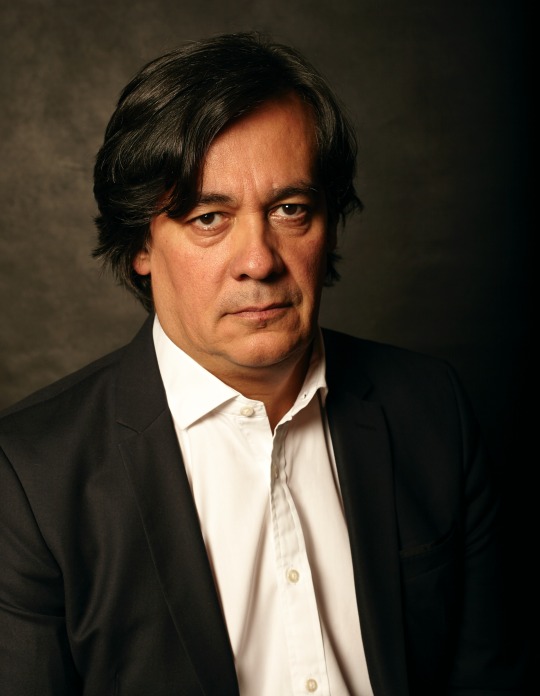
Leon Tovar, photo by Andres Serrano.
-------------------------------------------------------------------------------------------
Leon Tovar has been bringing important 20th-century Latin American art to an American and international audience for years – but that wasn’t always the program of Leon Tovar Gallery. When Leon opened his first space in Bogotá in 1991, he was focused on showing a roster of North American and European artists such as Sol LeWitt, Bernar Venet, and Josef Albers. It was only after moving to New York in 1998 that he realized there was a niche to fill: “I got the idea to make clear the real connections between Latin American artists and broader art history… I started to work here and present important programming featuring Latin American artists in different areas – geometric abstraction, optical, kinetic.”
Now the gallery, which is celebrating 30 years in business, is firmly focused on educating collectors about Latin American art and broadening the scope of the art historical canon.
We sat down to talk with Leon about the need to make cross-cultural connections throughout art history, the responsibilities of dealers and collectors, and the evolving role of digital tools in today’s art world.
When did you first become interested in visual art?
My experience with art started when I was around 7 years old. My father—who was a prominent lawyer in Colombia and a very intellectual person—used to paint over the weekends. And my mother, she always saved money to buy small pieces of art. From the beginning we had paintings on our walls and I was really passionate about that. When I started to paint at 8 years old, I was like a mini artist. And from that period I started to learn to be involved in the arts all my life. I never did anything else; that was my only career from the beginning.
When I was young there was an exhibition at the Museum of Modern Art of Bogotá, and it was one of my first exposures to geometric abstraction and optical art. A Venezuelan artist had been invited by the museum, probably Carlos Cruz-Diez, as he had a show there in 1985. After that, I became really passionate about how people can, with plasticity, communicate and express different ideas.
I went to Andes University to study art history, and when I was probably 18 or 19 years old I did an internship at a gallery in Stockholm. After that, when I was in my mid 20’s, I opened my first gallery in Bogotá in 1991 – as of this year we are 30 years old.
Early on, I was inspired after being invited by Sol LeWitt to his studio in Hartford. For my gallery in Bogotá, I started a program that brought international artists to the Colombian public, because it was difficult for people to go to museums in the States or Europe.

Leon Tovar at Sol LeWitt’s studio in Hartford, Connecticut, late 1980s.
-------------------------------------------------------------------------------------------
How did you meet Sol LeWitt originally?
My sister was also an art dealer, and she was married to a Swedish dealer. Together we started to make a plan for the gallery’s program. As I mentioned, very early on I was impressed with geometry, minimalism. We thought it was really important to bring LeWitt to Colombia.
He was really interested in doing something in Latin America because he had only been in one small show that had traveled to Bogotá, São Paulo, and Rio de Janeiro in 1975 – that was his only approach to Latin America. So, he invited us to his studio in Hartford. I was really impressed because he knew a lot about Latin American artists, especially those that we have worked with for many years, like Carlos Rojas, Eduardo Ramírez Villamizar, Edgar Negret. At that time, those Columbian artists were not even popular in Latin America or their own country.
The first show at the gallery ended up being Bernar Venet and Sol LeWitt.
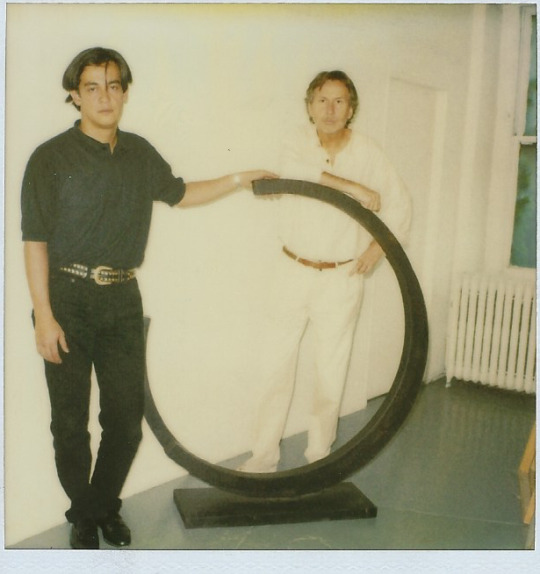
Leon Tovar with Bernar Venet at his studio, New York, 1992.
-------------------------------------------------------------------------------------------
Since those artists didn’t really have exposure in Colombia, did you find that people understood their work right away, or did you have to educate the public about them?
Their work divided people, immediately.
People who knew a lot about color theory, the theories of Josef Albers, understood. And later, we did an Albers exhibition in Bogotá, and people were thirsty to learn. Bogotá was a very well-known city for literature and art, and we have great artists there, but people didn’t have the same access to information. The budgets of museums were very limited.
A lot of people didn’t understand the work. If I sold a wall drawing by Sol LeWitt, and after the buyer received a certificate, and were told they needed to bring people to remake the wall drawing at their own place, they would ask, “Is this real?”
But the press was really good to us back then and we got a lot of articles all over Latin America. Venezuelan collectors started to buy from us. They sent curators to see our exhibitions and that’s why I survived this adventure. People thought it was a great idea to bring New York artists to Colombia and provide the public with access to their work. And on top of everything else, people could purchase the art if they liked it. We quickly became very popular in Latin America.
When you came to New York, did you find that these American artists you had shown in Colombia were already known and represented? Did you have an idea of representing them when you came to New York, or did you plan to bring Latin American artists to the States?
In 1998, I decided to move from Colombia to New York, both to gain another perspective for the gallery and because the situation had gotten so bad in Colombia that it didn’t make sense to continue in Bogotá. I moved to New York with the idea that the program would be more or less the same as it was in Colombia. But when I got here, Bernar was with André Emmerich Gallery, Sol was with Paula Cooper. I knew that now I was in the big swimming pool, and I got it immediately and I didn’t produce any resistance.
So I got the idea to make clear the real connections between Latin American artists and broader art history. Sol taught me there were no walls, no borders. He knew exactly who Carlos Rojas was, and the names of other Latin American artists that only professors knew. Then I understood there were no limits to the gallery’s program. I started to work here and present important programming featuring Latin American artists in different areas – geometric abstraction, optical, kinetic.

Leon Tovar Gallery, East 75th Street, New York. Photo by Peter Baker.
-------------------------------------------------------------------------------------------
Did you feel there was a lot of education you had to do with an American clientele, or do you think there was already an understanding here of Latin American art and its importance?
I had an advantage – I already knew how American artists worked, how European artists worked. I came here and learned a lot in the auction houses. I learned that we need to be very well-prepared with art historical knowledge in order to develop our program because most people have better ears than eyes. We need to explain to people how, why, optical art has been important. Why Yves Klein’s favorite artist was Jesús Rafael Soto. Why the Zero Group had connections with Latin American artists (one of the entrance pieces at the Guggenheim Museum for the Zero Group exhibition in 2014 was a Jesús Rafael Soto work). There are hundreds and hundreds of real connections, and this realization started from this chat with Sol LeWitt.
Museums started to become inspired, and in 2002, there was Body & Soul, one of the first important shows of art from Brazil at the Guggenheim Museum. It was probably among the earliest serious examinations of Latin American art.
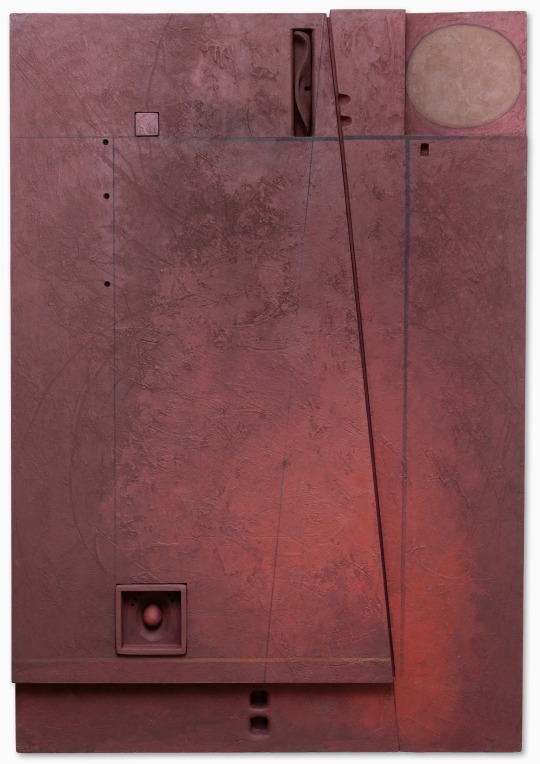
Marcelo Bonevardi, Rampart, 1969, acrylic and charcoal on textured substrate on wood, © Estate of Marcelo Bonevardi.
-------------------------------------------------------------------------------------------
Do you see yourself as filling in gaps in the art historical narrative?
If you’re a collector – a real collector – you need to find complements to your collection.
You can’t build a collection of Surrealists if you don’t include Frida Kahlo, Leonora Carrington, Wifredo Lam, Roberto Matta. You cannot talk about geometric abstraction without Carlos Rojas, Carmelo Arden Quin, Lucio Fontana. You cannot talk about Impressionism without Armando Reverón, Andrés de Santa Maria, because they were Impressionist artists also. If you are a landscape collector, you go to the School of Barbizon, but you also need to see the School of Quito. The light in Bogotá is the same light in Biarritz; the landscape artists have a connection over thousands of miles, even if they don’t know each other.
As a collector, you need to develop this expertise. If you don’t, it’s difficult. The gallery does a lot of work—we have a lot of space to cover, and thousands of collectors don’t have this knowledge of Latin American art. That’s why we started to be important, because people realized the need to make connections along the whole spectrum of art history.

Leon Tovar Gallery at ADAA’s The Art Show, New York, 2020. Photo by Nicolas Manassi.
-------------------------------------------------------------------------------------------
When you come to a new geographic region and you have to build a market for an established artist from elsewhere, you’re really building the market from the ground up. As the business owner, that is a long-term strategy and that doesn’t happen overnight – so here you are, starting a young gallery in the US, and you’re having to create a long-term view for it that may not have immediate financial benefits.
It’s a huge sacrifice. Huge. As difficult as it was to bring Sol LeWitt or Josef Albers to Bogotá in the late 1980s or early ’90s, it was just as difficult to bring artists like Carlos Rojas, or Eduardo Ramírez Villamizar, or Carmelo Arden Quin, or Sergio Camargo to America. And obviously New York is a very competitive city, but we love that type of competition.
Some of the artists we worked with in the beginning didn’t have any museum exhibitions or any really important approval from collectors. Over time we saw that change, and we saw their prices rise. We’re working with the most important of these big artists from Latin America. They are part of the art world, and there’s no room for speculation.
There are of course a lot of people that deal art for passion, knowledge, and education. And when people are really passionate, they never give up, even if they’re not economically successful. Obviously, the economic part is important, because you need to survive. But if you focus on one specific area and develop that knowledge, build the right program with the right artists, this will bring you success, sooner or later. It may take a long time, but don’t be stressed about the economic part because it will come; if you have a serious vocation, people will start to recognize that.

Leon Tovar with Jesús Rafael Soto and Carlos Cruz-Diez, Caracas, Venezuela, 1993.
-------------------------------------------------------------------------------------------
Is there any advice you may have for new collectors?
Like dealers, there are different kinds of collectors.
Some young collectors are interested in collecting because they saw it in their own families and they want to continue the tradition, which is fantastic and beautiful.
Another type of young collector sees a business opportunity. That’s important, too, for the market. But if you want to build a long-term project, and want the dealers and galleries to respect you and give you the best information, you need to act responsibly as a collector. You have privilege, yes, but also obligations to the galleries and to the art that you buy. There are protocols that you need to follow. It’s a big responsibility. It’s more than people think.
If you educate yourself, you will always be a successful collector. You need to learn a lot, read a lot, go to museums. You don’t need to be rich to start to collect. The Vogels are a beautiful example that you can be the best collector ever, just with knowledge. Start now, start as soon as possible. It’s important. If you buy a nice art piece, and you start to build your own collection, that will put you in a position to collect further. Start today.

Leon Tovar Gallery at Bogotá International Art Fair, 2016. Photo by Mateo Saenz.
-------------------------------------------------------------------------------------------
In this past year, a lot of the ways in which art dealers do business has changed. Can you talk about some of the changes you’ve seen, whether positive or negative?
I could spend two hours answering that question. I think today, the most important shift as a result of the current need for digital outreach is that galleries have started to be important again.
Important galleries – no matter their size – will survive, and prevail, because now collectors, more than before, need to have confidence in their dealers. They cannot go to art fairs, and they need to trust in the expertise of the gallery. If people want to buy Latin American art, they would prefer in this case to buy it from us, or from a serious dealer from Latin America, rather than to try to buy things online from someone they don’t know.
Digital tools give us an advantage but can also work against us. At the end of the day, you don’t always have control over the information that’s put out into the digital world. It’s a very risky moment right now in terms of information, and misinformation, too.
But in the pandemic, if you use these tools with level-headedness and with discretion, like we do at the gallery, it’s an advantage. They help a lot. You can do digital exhibitions. But at the end of the movie, galleries will be there forever. I think we are, in our case, using our platforms very responsibly. We don’t want to be aggressive with people because they are fatigued with digital platforms. You need to manage that.
I think you make a compelling and resonant point – while the digital platforms provide access, nothing can replace the value of humanity and personal relationships. And it is the relationships that will ultimately survive this process.
Exactly—it’s the sharing of knowledge. Knowledge is not Google. Dealers need to build experience, to spend the hours, spend your life, your money, your energy, probably your own private life. As a dealer you need to educate yourself, as much as an art historian. When you do this, you dignify the whole ecosystem, with collectors supporting galleries, galleries supporting artists, and artists supporting museums.
You can’t do everything online – that’s why museums postponed exhibitions. It doesn’t make sense to spend millions of dollars to do an online Francis Bacon retrospective. You need to bring people to the museum so they can see why Bacon is Bacon.
We will be back in person eventually, and will also continue making use of digital platforms. But we, at the gallery, will go back to our roots because a year ago we were so crazy and in such a rush. The fairs, the exhibitions, and also the preparation of these events – it’s a huge responsibility, a huge undertaking. Even though we are a small gallery we have a big operation.
Now we’re calmly developing our program. We’ve deaccelerated our process. We are going slower, but we are more precise and focused. You learn to be more selective with your time, and think seriously about what you want to do in the future. The collectors will come to you. If you have good work, they will come.

Leon Tovar greeting the King and Queen of Spain at ARCOmadrid, 2015.
-------------------------------------------------------------------------------------------
In the course of these conversations, themes develop organically. Responsiveness and shifting goals to meet your situation seems to be a theme for you.
It’s a combination of opportunity and resourcefulness – together, this makes you lucky.
We take opportunities. We’re competitive, we’re active, and we know what we’re doing.
100 years from now, 200 years from now, what do you hope will be the legacy of your gallery?
I’d like to think that a crazy, small gallery from Colombia started a project that eventually was developed for universities, for education, for the future. I think that Latin America, as a vast region, has suffered a lot. The artists from these countries make incredible efforts to manifest their own feelings and ideas, and are as important as any other artist in the world.
I think the most important thing is that people realize that knowledge is the key part of our program. We are here – humbly – to educate people about Latin America and the connections that exist between our artists and the rest of the world.
-------------------------------------------------------------------------------------------
All images courtesy Leon Tovar Gallery, New York.
2 notes
·
View notes
Text
Exploring the Gifts in the Art Gallery of Guelph
Enos Mills and Freeman Tilden, both contributors to our ENVS*3000 required reading The Gifts of Interpretation, agreed and wrote that a nature guide is also an artist. This week, we will dive into an artist’s view whom shares the three gifts of story, provocation, and hope that are discussed within the textbook. The exhibit created by Glenna Cardinal, was presented by a wonderful tour guide at the Art Gallery of Guelph. My Nature Interpretation class had the exciting opportunity to be lead through the art exhibit for one of our seminar’s earlier on in the fall semester, introducing the connection between nature and art.
How did these three gifts resonate though the artist’s exhibition?
The Gift of Story
When my class first arrived at the exhibit, we were told to walk around the room and try and make connections between the different art forms that were presented. The artwork was compelling to look at, striking curiosity and interest as my eyes tried to reveal the secrets and emotions hidden within each piece. I remember seeing home furnishings, taxidermy, and rocks from the area around her former childhood home. As our tour guide began to move to piece to piece, I could see the significance of each part that created the whole story. Cardinal’s work explores themes of land and home, displacement and loss related to the construction Calgary’s Southwest Ring Road through Tsuut’ina Nation. The gift of story was evident as it was informative, inspiring and entertaining through multiple methods of art.
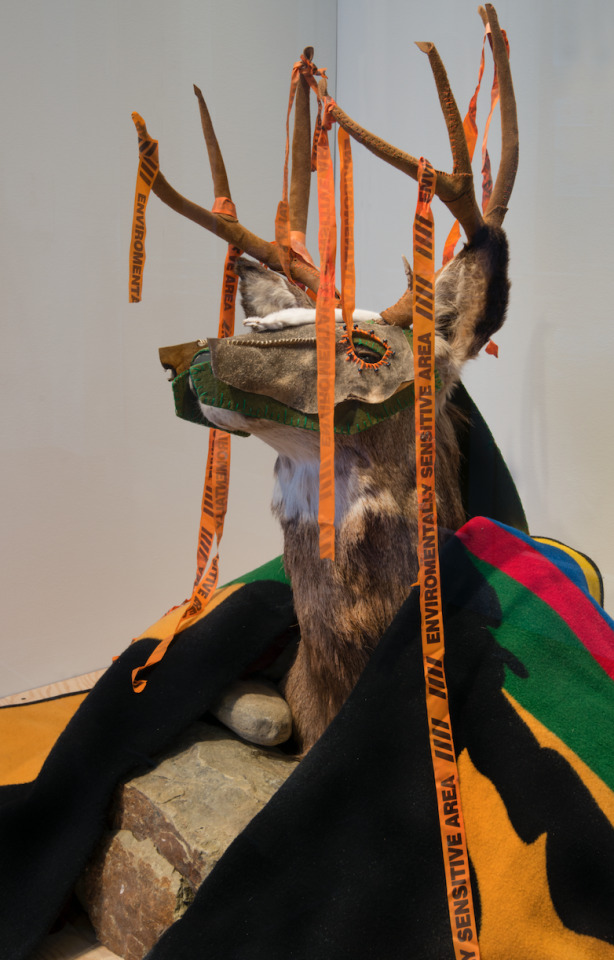
Photo showing a taxidermy art piece included in the exhibit. Picture taken from here.
The Gift of Provocation
“Most visitors to interpretive settings are interested and eager to learn the deeper truths of the places they have been selected to experience” (Pg. 31, Chapter 4, The Gift of Provocation). The gift of provocation occurs when the interpreter adds intellectual spice to basic emotions, which then motivates their audience to further educate themselves and to maybe even take action. Interpreters entice visitors to learn more about the cultural and natural history of an area through their own passion for the place. In this case, a place where Cardinal called come. I remember being very intrigued, asking many questions to the tour guide and even having a discussion with my professor at the time Amanda H. Through the gift of story, we could see emotion invoked from every piece of art. Emotions like anger at the loss of the land. The feeling of confusion and hurt for having a home in the Tsuut’ina Nation but failing to receive any compensation for the loss of her home because of rules set out by their community. No settlement money, and only loss.
The Gift of Hope
“You give but little when you give of your possessions. It is when you give of yourself that you truly give” – Kahlil Gibran
Sharing a deeply personal journey that may not be pretty, is the act of giving yourself. It can be extremely difficult to share and express the hardships one is facing. Cardinal’s work expresses the hardships and losses that she encounters as she is forced to leave her childhood home and community. Although conflict is painful, the art exhibit proves to be the perfect example of how it can be educational as well. Glenna chooses to push boundaries to provide awareness of impactful events happening on First Nations land that will no longer be completely preserved. Acknowledging and confronting problems that are occurring is the first step in gifting hope to the audience. I think that by expressing and sharing Glenna’s talent within different art forms is how she gives the gift of hope to those experiencing her exhibit, and those within her community who were at a loss as well. However, I think this gift can be further developed in a way that the audience can see past the pain and loss. If the audience can receive hopeful messages while also being confronted by the issues Cardinal is presenting, one can be both aware and motivated to move in the right direction. This is a small aspect that would help deliver the gift of hope to the audience in a more wholesome way.
Did you experience these “gifts” during our seminar at the Art Gallery of Guelph? Were there other “gifts” that you thought were more present?
Thank you all for tuning into this week’s post!
Sophia
References:
Beck, L., & Cable, T. T. (2011). The Gifts of Interpretation: Fifteen Guiding Principles for Interpreting Nature and Culture. Urbana, IL: Sagamore Publishing
1 note
·
View note
Text
Interview with Shannon Pelletier
By: Sam Hawkins

Note: Shannon’s show, The Circle of Artistry is up for the month of February in Vault Gallery.
Ayris: We, here at Ayris, have heard that you’re currently working on a project taking photos of your fellow artists in their senior studios and workspaces. What is your vision of the project and what do you hope to capture through these photos?
Shannon Pelletier: The rumors are true! Yes, I am currently working on a documentary series, in which I photograph artists in their creative spaces. The work is a variety of photographs - some are of artists actively working on their own artwork. Others are formal portraits of the artists in their studios. The series is an inclusive body of work. So, I would ultimately like for it to expand. This would entail photographing more students, faculty, and even off-campus artists, with a wider range of artistic processes and media. I am very inspired by the processes of other artists, photographers included, and it’s something I’d like to continue to document. Following the process, I’d like to capture the relationship that the artists share with the work that they’ve made.
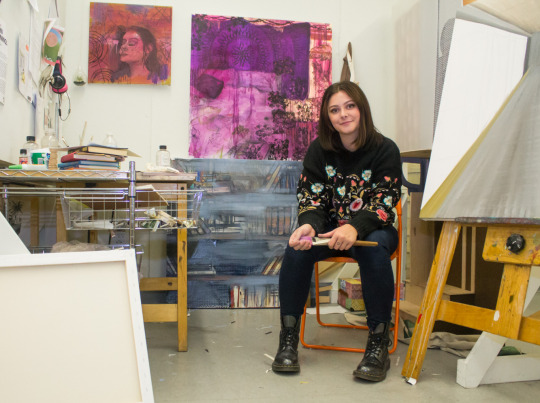
A: What drew you to this idea? What do you find so special about artists at work and why did you feel the need to capture it?
SP: What initially drew me to this concept was watching my friends make work in their studios. I watch them turn plain canvases into alluring 2-D works of art, or turn lumps of clay into beautiful and/or functional ceramic pieces. The list goes on. Watching another creative person create is, to me, like alchemy. The project reflects my standpoint of admiration, for the artists, processes, and finished byproducts.
A: Do you have any favorite shots you’d like to share with us, and can you explain why you are so fond of them?
SP: Absolutely! Here are a few!
I once showed this portrait to a group of people in class and someone said, “You know her so well just by looking at this picture.” I know her well already, so it’s really special that viewers can get to know her a little bit, too. The art people make and the way they decorate a space are often very telling of who they are.
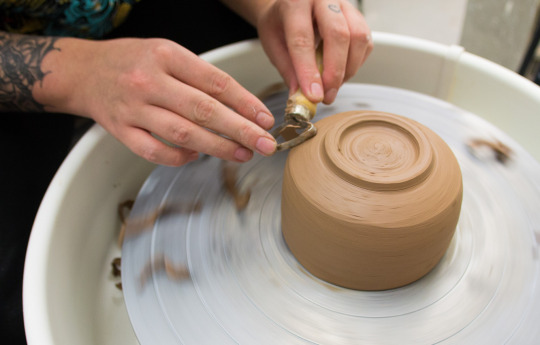
I love to photograph the hands of people working, especially in ceramic work. I actually was given the opportunity to not only photograph ceramic artwork being made, but also learn how to do it myself! It’s a craft that takes a lot of mental focus, but also physical dexterity and grace.

I loved photographing Devin because she was so eager to share her art and space with me. With each portrait I shoot and new interaction I have, I get to learn so much about the artist. It’s always a great experience!
A: What technical challenges did you have to solve to compose these images?
SP: Luckily, this project hasn’t been too challenging, technically. I carry an external flash to compensate for light in darker spaces. I also carry a wide-angle lens, which I use when taking environmental portraits. This allows me to capture as much or the artist’s surroundings as possible.
A: What inspiration do you draw from your peers, especially seeing them in their senior studios?
SP: My peers are the source of all inspiration for this series. As I’ve mentioned, it fascinates me to watch them work. I’m interested, so I document it. They are creating work, and in my photographing, I am too. Suddenly, everyone in the room is working to create. The energy in the studios is great - it’s fun and productive for everyone involved! Also, so many artists have told me that they have never had their picture taken with their artwork, and the ability to give them that photograph is a real privilege.
A: Nearing your senior show, can you give us any sort of clue on what it will focus on? Will it be centered around things like this project?
SP: Yes! My BFA exhibition work and my studio portraits are actually two totally unrelated projects. The subject matter of my senior work are botanical objects and other objects found in nature. The project is reflective of my personal history, but also touches upon concepts such as memory and impermanence. It’s still a work in progress, but time is flying by and I’m so excited for May!
A: I’m sure you have your nose to the grindstone, focusing on this project and looking forward to graduation, but I’m interested to know, looking back, what you will miss and value most about your time here?
SP: Wow…so much! It’s hard to even picture myself not at NHIA, but I do know this: I’ll miss my professors and having their guidance. They are so knowledgeable and I love to learn from them. Also, living in a community of artists is such a rich and inspiring thing. I’ll miss being surrounded by other creative people. I value so much from my time here, that it’s difficult to articulate. I value the skills I’ve acquired, critiques I’ve received – good and bad, art I’ve gotten to see, visiting artists lectures I’ve heard (yes, really), connections I’ve made, and of course the incredible people I’ve met in this community. Enjoy it while you can!
A: Do you have any final words for our readers, regarding art and anything about your projects?
SP: Of course! Thank you to the Ayris team for reaching out to me – I love seeing that people in the NHIA community are taking interest and liking this body of work! Thank you to the artists who have already participated or expressed interest in this documentary series. This is my first time making portraiture photography and I appreciate their enthusiasm so much.
Lastly, this body of work is not complete, if it ever will be. I am always looking for artists – of ANY media - to photograph. If you’re interested, please don’t hesitate to email me at [email protected], or direct message my Instagram page @shannon.m.pelletier. I’d love for this to be a huge series, so I’d love to come see you and your art!
2 notes
·
View notes
Text
The Dude with the Glowing Paint | Artist!Bucky Barnes x Gender-Neutral!Artist!Reader
Summary: art’s great, but spending hours in a small gallery can get very boring, very fast, but meeting another artist makes it better
Warnings: one Titanic reference, lil’ bit faster past than usual, more of a 40’s!Bucky personality than Post-Hydra!Buck, nothing else I don’t think
Word Count: 1.1k
A/n: first off, thank you very much @stardustandbucky for motivating/encouraging me, I started 3 fics and got around to labeling the others
Also, I spent at least one day a month in my grandma’s art gallery since I can remember—sometimes other galleries—so this is all very familiar and if you’re wondering, this is the weird plastic cup I’m talking about in this fic
— — —
Standing in front of one of the largest paintings, I frowned—I missed a spot when I went over it with a fine tooth comb.
I had graduated art school a year ago and I was lucky enough to get my art into a gallery via the help of a friend’s friend. It also meant I’d have about ten feet more of space in my apartment for a month.
As it was opening night of my exhibit, I decided to wander around until I had to go to work—lucky it was also the opening night for another artist about thirty paces away from mine, so we had each others friends mixing—not that I knew who the other artist was.
“You’re staring very intensely at that flower.”
I glanced to my right, seeing a guy with smirk—much more casual than literally everyone in the building. He had his hair in a bun and punch in one of those weird shaped plasic cups that were supposed to look like glass.
“Zoned out,” I said, taking a deep breath and looking back at the painting. I hadn’t socialized with straight up strangers since the beginning of art school.
“First honest person tonight,” he commented.
I let out a laugh, covering my mouth. “‘Know what you mean, second honest person,” I said, smiling.
“So which is your favorite?” He asked, making a vague motion towards my exhibit.
“My grandma would say you can’t choose a favorite,” I said slowly. “I’d say I prefer that other dude’s art.”
He chuckled. “Dude,” he started, smiling, “I have to disagree with you.”
“Arguing with you would be like arguing about music,” I sighed out, shaking my head with a grin. “But’cha’re wrong—that dude uses glow-in-the-dark paint, this dude doesn’t.”
“You noticed that?” He asked with a bit of astonishment.
“It’s got that weird green tint,” I shrugged, looking back at him, and studying his face this time—a half smirk half smile, gentel blue eyes and his eyebrows were furrowed, skeptically.
“Glow-in-the-dark paint makes you like that dude more than this one?” He asked.
“Totally, I have no respect for anyone who doesn’t use glow-in-the-dark paint,” I said, half joking.
He hummed, nodding. A blonde guy came up to him and tapped him on the shoulder. “Hey, Bucky, Peggy and I are gonna head home,” the blonde guy said. “Have fun with that sarcastic flirting.”
“Dunno what you’re talkin’ ‘bout, and it’s a lot better than the flustered flirting you do,” he said. “See ya later, punk.”
When the blonde one left, I leaned towards him. “Bucky as in the dude that uses glow-in-the-dark paint?” I asked, raising my eyebrows mischievously.
“Knew I should’ve used James,” he said, sticking out his hand. “Bucky Barnes, nice to meet you.”
“(Y/n) (y/l/n), pleasure to make your acquaintance,” I said, shaking his hand. He raised his eyebrows and jabbed his thumb towards my painting. I just nodded.
“How does a proper artist like my stuff?” He asked.
“Proper artist? You have an exhibit at the same gallery as I do,” I said, rolling my eyes. “And ya gotta reevaluate your view on my taste, because I really want to go check out the paper mache cat show on the floor below us.”
“There’s a paper mache cat show? Would anyone be angry if we abandoned this and went down there?” He asked, with hopeful wide eyes.
“We don’t technically have to be here, it’s just polite to watch people judge your abilities—let’s go look at paper mache cats,” I said, smiling.
We ran off like children to the lower floor, abandoning the formality of our gallery and stepped into a crazy room full of wild people and colorful paper cats.
“I suddenly feel very over dressed,” I commented as we entered the gallery.
“Considering there’s a lady wearing a bright orange feather scarf, I wouldn’t worry about it,” he said with a smirk.
I let out a laugh. “Dude… that scarf looks fabulous,” I said, playfully punching his shoulder.
“If I could find one, think I could pull it off?” He asked.
“Oh, if you find one, you find me, and I will a sketch you wearing it and make sure it goes down in history,” I said.
“That a promise or a threat?” He asked. “I think that would be a great way to go down in history.”
We walked around the gallery, joking, laughing and admiring paper cats. He went to put his empty punch cup in the recycling bin and cane back with two bowls of ice cream.
“Wasn’t sure if you wanted chocolate or vanilla, so your pick,” he said, holding them both out.
I carefully picked up one, smiling. “What do I owe you?” I asked.
“A sketch of me in an orange feather scarf,” he said. “Nah, don’t worry about it, it was free.”
“Free ice cream and a causal atmosphere—there doing it wrong up stairs,” I said, smiling happily.
“They are,” he agreed with a mouthful of ice cream.
We continued to wander around till we saw every paper cat twice and all the photos on the walls. We talked about how we got into painting—I was born into it and he picked it up as a hobby, “art therapy, really” he had corrected himself, and his friends persuaded him to try to put it in a show.
He also said he had to be careful about where he put his paintings because having glow-in-the-dark paint stare you down while you tried to sleep was unnerving.
An alarm on my phone went off, interrupting my story about my weird professor who wore kilts and flip-flops to class year-round.
“I’ve got to get to work,” I said, letting out a sigh. I ummed for a moment before pulling my card from my cardigan pocket and held it out to him. “Text me if you find an orange feather scarf—I don’t answer calls if I don’t know the number.”
— — —
Bucky and I texted over a month, a met up with him for lunch a couple times with his friends or mine—the only real difference between his and mine were mine were mostly artists who still ate instant ramen noodles and most of his were over achievers; two of them were engaged, completely over achieving.
One afternoon, after a long nightshift at the diner, I received some texts from him while I made coffee.
Bucky: Dude
Bucky: Dude, guess what
Then a selfie came in of him in a fluffy orange feather scarf, beaming. It looked like he was in a homemade soap and crafts shop.
Bucky: Jake, I want you to draw me like one of your French girls,
Me: Don’t finish that quote
Me: I drew a French girl once, in a baggy sweater and sweatpants
Bucky: Do you still have that drawing?
Bucky: If I take you out to dinner, can I finish that quote?
Me: Did you just ask me out?
Me: I mean yes, to both of those things
#bucky barnes x reader#bucky barnes x you#bucky barnes x y/n#bucky barnes x gender neutral reader#bucky x reader#bucky x you#bucky x y/n#bucky imagine#bucky fanfic#artist!bucky
5 notes
·
View notes
Text
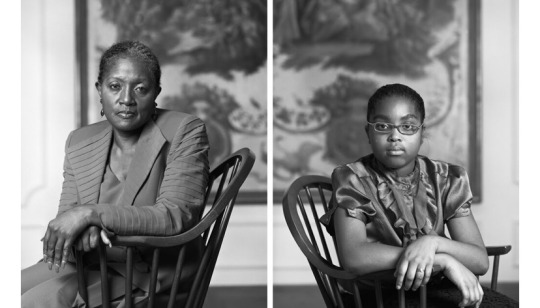
Dawoud Bey, Betty Selvage and Faith Speights, Birmingham, AL, from The Birmingham Project, 2012. Pigmented inkjet prints, 40 × 32 in. each (101.6 × 81.3 cm each). Rennie Collection, Vancouver. © Dawoud Bey
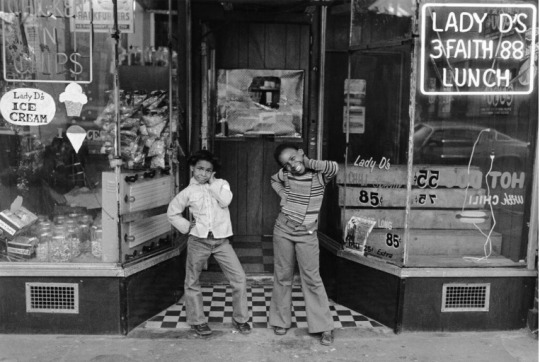
Dawoud Bey, Two Girls at Lady D's, Harlem, NY, from Harlem, U.S.A., c. 1976. Gelatin silver print (printed 2019), 11 × 14 in. (27.9 × 35.6 cm); 16 3/8 × 20 5/8 × 1 1/2 in. frame. Collection of the artist; courtesy the artist and Sean Kelly Gallery, New York; Stephen Daiter Gallery, Chicago; and Rena Bransten Gallery, San Francisco. © Dawoud Bey. Image courtesy the artist and Stephen Daiter Gallery, Chicago
Dawoud Bey’s work, “ An American project,” located at the Whitney Museum of Art on 99 Gansevoort st New York, Ny 10014. Traces across the forty-five years of Bey’s career and his profound engagement with young Black people and African American history. Consisting of 44 photographs and 8 projects within the Exhibition.I have seen that he is deeply committed to the craft of photography, drawing on the medium's specific tools, processes, and materials to amplify the formal, aesthetic, and conceptual goals of each body of work. Bey views photography not only as a form of personal expression but as an act of political responsibility, asserting the necessary and ongoing work of artists and institutions to break down obstacles to access, convene communities, and open dialogues. Dawoud Bey was born in 1953 in Queens Ny, In succeeding decades and successive bodies of work, Bey has moved from working in the streets with a small, hand-held 35mm camera to creating more formally structured portraits using a tripod mounted 4 x 5 camera and the monumental 20 x 24 Polaroid view camera. He has a Master of Fine Arts degree from Yale University School of Art and is currently Professor of Art and a former Distinguished College Artist at Columbia College Chicago. In 2017 Bey was awarded the MacArthur Foundation “Genius” Fellowship. He is also the recipient of fellowships from United States Artists, the John Simon Guggenheim Memorial Foundation and the National Endowment for the Arts, amongst other honors.His work has been included in important solo and group exhibitions worldwide and is included in the permanent collections of the Addison Gallery of American Art, the Art Institute of Chicago, the Brooklyn Museum, the Detroit Institute of Arts, the Fogg Art Museum at Harvard University, and many more.
The images I have chosen both have great meaning and history and emotion behind them, they both made me feel proud of my culture and think about the past events that occurred in African American History. The first image is of Betty Selvage and Faith Speights in the Birmingham series, this image attracted me because of the deep meaning behind it. In 1963 the Ku Klux Klan bombed the 16th street Baptist church in Birmingham, Alabama killing four African American girls and boys. The way this picture is set up is that a younger person around the age of the younger people that was killed on one side and the other side represents the age they would actually be if they were still alive which is the older person on the other side. I admire the thought behind this picture and the honor he wanted to show when creating this piece. I also like how the photo is in black and white because it captures all the beauty and emotion through their facial expression without color so there’s nothing to distract you with other than the raw emotion that you feel from the two girls. The way the young girl and the women are sitting the same way and looking at the camera I think is brilliant because it makes you think they are the same person just grown up which is the idea that Bey was essentially trying to give and he was successful. The next image that I found interest in was Two Girls at Lady D’s Harlem Ny in the Harlem series. This photo made me think of when I was a little girl and seeing those little girls standing outside of the ice cream shop brought back all the innocence and fun that I had growing up. When I look at this picture I notice the 85 cents on the window and it says lunch , it's such a massive difference compared to the world now I want to almost jump into this photograph to see how Harlem was in 1975. I love that Bey is showing off the community that these two Black girls are in and the black and white colors again show the pureness of these little girls. Both of these images display life in Black communities and capture the events that were going on during that time.
Dawoud Bey’s overall message is shining the light on race,place and visibility in American History. Bey explores photographs potential to reveal communities that may be unseen or even unrepresented because of their race or gender. He calls it, “a form of personal expression and an act of political responsibility,” Bey’s art assert’s on the power of photography to transform stereotypes, convene communities, and create dialogue. Each of his series all come together to make up the American project, each of them tell a different story and show a different side of cultures and history. That's what I love the most about his artwork. They have true meaning and such power. Bey has been awarded the Guggenheim Fellowship for Creative Arts, US & Canada in 2002, he is talked about highly in the New York Times and is quoted to have, “ powerful photographs of African Americans.” I hope to review more of Dawoud Bey’s work as it is truly phenomenal and powerful.
Extra Credit : Dawoud Bey at The Whitney Museum of Art
0 notes
Photo
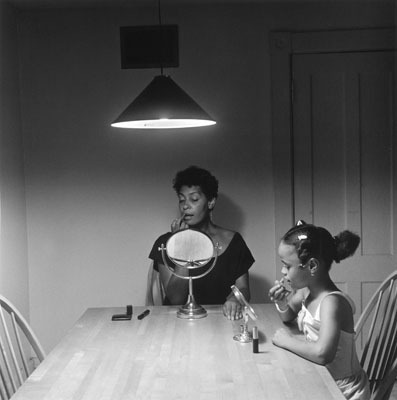
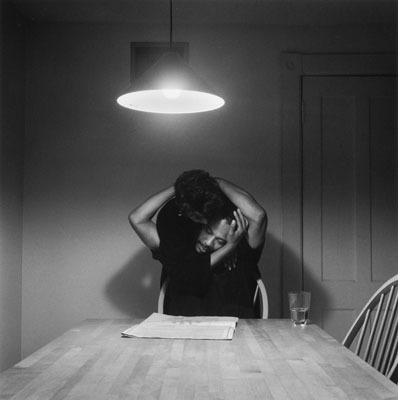
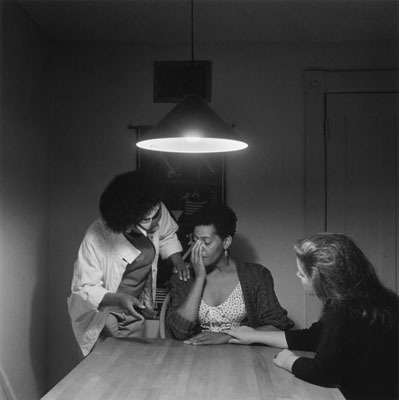
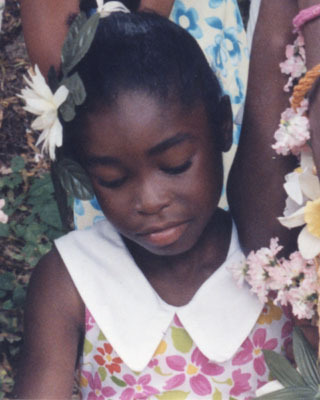
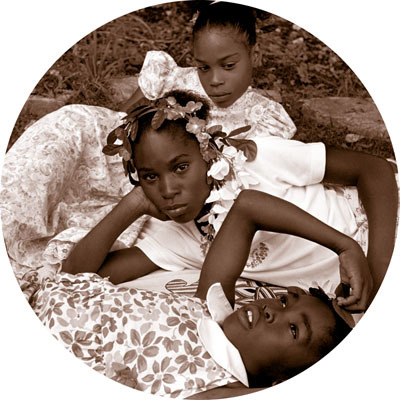
Aaliyah Wilson
Professor Nichole Frocheur
Mini Research Project
4/19/21
The first two photos is from Carrie Mae Weems work The Kitchen Table(1989-1990),The last two is from Carrie Mae Weems work Mayflower(2003)
Corrie Mae Weem is an American photographer and artist. She was born April 20, 1953, in Portland, Oregon. She has award-winning photographs, films, and videos that have been on display in over fifty exhibitions in the United States and abroad.In her work she focus on serious issues that are facing African Americans today, like racism, gender relations, politics, and personal identity, she was politically active in the labor movement as a union organizer. And she would take photos for political reasons before she started to take them for artistic purposes. She was inspired to pursue photography when she came across The Black Photography Annual, a book of images by African-American photographers. The book contains the work of photographers Shawn Walker, Beuford Smith, Anthony Barboza, Ming Smith, Ader Cowans, and Roy DeCarava.
One of Carrie Mae Weems’s projects that I was researching is The Kitchen Table. . She had been working on this project from 1989-1990. The project contains 20 photographs and 14 text panels. She used one source of light in each of the photographs. In this project, she wanted to tell a story of one woman's life as it is conducting in her kitchen. And sharing the experience around family dynamics, friendship, and the war between the sexes. The kitchen frames her story, one of the primary spaces of domesticity and the traditional realm of women, which reveals her relationships—with lovers, children, friends—and her sense of self, in her varying projections of dominance, weakness, aloofness, tenderness, and solitude. Carrie Mae Weems would describe the work of art depicts “the battle around the family ... monogamy ... and between the sexes."
The second project of Carrie Mae Weems that I was researching is the Mayflower (2003). The mayflower shows African American girls in flowered dresses spread out in decorous repose on shady lawns or dance around a maypole in this project. Simultaneously, she exposes a harsh irony: in the nineteenth century, young African American women were much more likely to serve as servants in upper-class homes than to appear in the formal portraits that decorated their drawing rooms. This historical fact contrasts with the girls in the picture who seem to be living a life of leisure. Mayflower is one of Weems first that won a MacArthur Fellowship in 2013 to enter the collection of the National Gallery of Art. It was also acquired with Alfred H.Moses and Fern M. Schad Fund.
I really enjoy researching her works,I love how she tell her stories in all her projects.Especially in her project The Kitchen Table showing,how intimate the kitchen table space can be in your house.For me I can relate because my kitchen table is such an intimate space in my house and just somewhere I had good, bad,and even sad moment. Also love in her project the shows the injustice in the African- American community in her photograph. And I think her making some of her projects black and white really helps to draw you into the photo. With her doing this i was able to relate to the photos more then if it’s was in color.
Works Cited
Goodlin, Lisa. “Carrie Mae Weems.” Carriemaeweems.net, 2010, carriemaeweems.net/index.html.
VALENTINE, VICTORIA. “Carrie Mae Weems on Kitchen Table Series: ‘Not Simply a Voice for African American Women, but More Generally for Women.’” Https://Www.culturetype.com/2020/08/13/Carrie-Mae-Weems-On-Kitchen-Table-Series-Not-Simply-a-Voice-For-African-American-Women-But-More-Generally-For-Women/, 13 Aug. 2020, www.culturetype.com/2020/08/13/carrie-mae-weems-on-kitchen-table-series-not-simply-a-voice-for-african-american-women-but-more-generally-for-women/.
0 notes
Text
Joseph Becker
Associate Curator of Architecture and Design
San Francisco Museum of Modern Art
San Francisco, California
sfmoma.org
Photo by Matthew Millman
SPECIAL GUEST SERIES
Joseph Becker is associate curator of architecture and design at the San Francisco Museum of Modern Art. He has contributed to over twenty exhibitions at the Museum, including the curation of Tomás Saraceno: Stillness in Motion – Cloud Cities (2016-17), and Field Conditions (2012), as well as the co-curation of Nothing Stable Under Heaven (2018), Typeface to Interface: Graphic Design from the Collection (2016), and Lebbeus Woods, Architect (2013-14). During his 11-year tenure, Joseph has also been responsible for numerous major acquisitions for the Museum’s collection, as well as exhibition design and visual direction of many of its architecture and design exhibitions. He has served on architecture, design, and public art panels; been an invited juror at national architecture programs; led workshops on exhibition and experiential design; moderated public dialogue; and lectured internationally. Joseph earned both a bachelor of architecture and a masters of advanced architectural design (in design theory and critical practice) from the California College of the Arts, where he is currently a visiting professor. When Joseph is not working, you can find him sailing his 1979 Columbia 9.6 on the San Francisco Bay, or working on a slow remodel of his 1948 house in Bernal Heights.
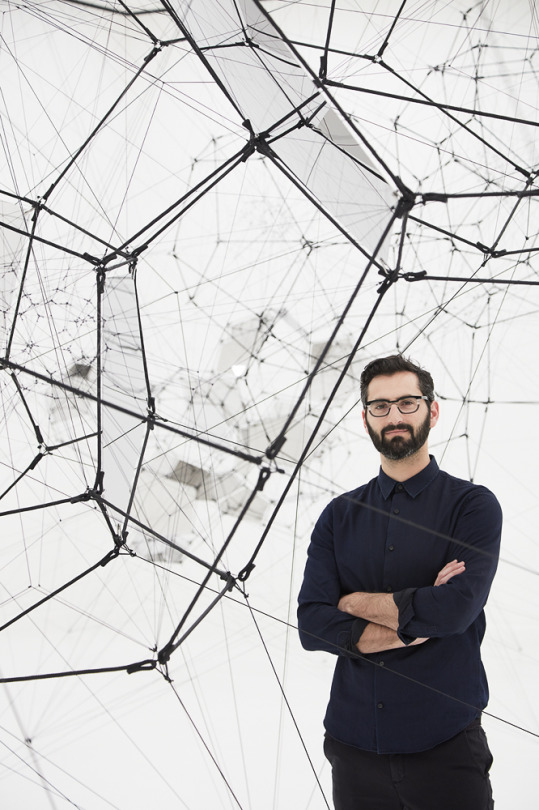
FAVORITES
Book: I really avoid playing favorites, and I love books, so I’ll just say that Reyner Banham’s Los Angeles: The Architecture of Four Ecologies is always on my list of required reading, both because of my interest in architecture and as a native Angeleno. I don’t have much time to read for fun, so I’m currently picking at short stories by George Saunders. Just the right amount of weird.
Destination: Marfa. Worth the journey. I’ve been lucky to visit a handful of times over the past few years, doing research on Donald Judd’s furniture practice. The wide open sky of West Texas has a very special quality.
Motto: I once had a keychain that said “Screw it, Let’s do It.”
Prized possession: Right now I’m really excited about my 1953 O’Keefe and Merritt stove, which I just put into my kitchen. I have many small collections of really wonderful and quirky objects, but I love the four-inch pine needle basket that my mom wove for me at our family forestry-service cabin in the Sierras, where I am right now.
THE QUERY
Where were you born?
At home in Los Angeles.
What were some of the passions and pastimes of your earlier years?
Certainly when I was a child I was a big Lego fan. But I also took art classes at Dorothy Cannon’s renown studio in North Hollywood, which exposed me to paint and clay and charcoal. She was an amazingly encouraging teacher.
What is your first memory of architecture as an experience?
When I was four, my parents bought their 1930s ranch house across the street from my mom’s sister, and worked with an architect to build an addition. I have early memories of exploring the house under construction, and especially sitting at the bottom of the empty swimming pool and marveling at the scale and curves and very different quality of space inside the concrete shell.
How did you begin to realize your intrigue with architecture and design?
I think I was always interested in building and making things, even as a child. My dad and I used to make model rockets, and we built my bedroom furniture to my designs when I was around 13. I also remember traveling with my parents in the UK when I was 14, and chose to take them to the Design Museum in London because of an ad I saw in the underground. It was a Verner Panton exhibition, and from then on I was hooked on the idea of total environment. The psychedelic aspect was pretty good, too.
Why does this form of artistic expression suit you?
I think I’m interested in the logic of design and architecture – the creative response to problem solving. But I really get excited when the boundaries break down, and the architecture or design response is an artistic critique of societal conditions, and perhaps a vision for an alternative future.
What led to your coming on board with the San Francisco Museum of Art?
I knew I wanted to study architecture, but not necessarily practice it. My interest in art led me to explore curatorial practice as a way to combine the two.
What is your greatest challenge in this role?
Each exhibition or program has unique challenges. Working with living artists is a really exciting challenge – pushing and pulling in a dialogue while keeping their vision pure. I think the greatest challenge is that I never feel like I have enough time for robust scholarship on any exhibition, no matter how far in advance I begin planning.
Is there a project along the way that has presented an important learning curve?
Each project is an opportunity for growth in a different arena. I think my very first project at SFMOMA, which was designing the giant walk-in freezer that housed the Olafur Eliasson ice-covered hydrogen powered race car chassis called Your mobile expectations, set a high bar. The car fit in the freight elevator by two inches and we had a pretty hard time calculating what it would weigh once laden with its frozen shell.
What exhibition remains most memorable, even today?
There are two exhibitions I have curated that I actually see as a continuation of a single idea. Field Conditions (2012) and Tomás Saraceno: Stillness in Motion – Cloud Cities (2017) each deal with pushing the boundaries of architecture as conceptual spatial practice, with foray into the hypothetical and visionary. I worked with some amazing artists in Field Conditions, and was very excited to put drawings by Lebbeus Woods on view that I had studied in undergraduate school. I acquired those drawings for the Museum collection, and then co-curated the first comprehensive survey of Woods’ work after his passing.
How would you describe your creative process?
As a curator, you’re always looking around for new artists and projects, and connecting them to explorations in the past. I think my process is really just about trying to see as much as possible and trusting my instinct when it comes to what I think is interesting, and want to share with the Museum’s audience.
What three tools of the trade can’t you live without?
I’m completely indebted to our museum library, and the ability to access hundreds of amazing publications. Obviously the internet is an indispensable research tool, but I try to not get mesmerized by it – you can get tangential quickly. And without my glasses I’d have a hard time doing anything, so I have to credit LA Eyeworks for keeping me bespectacled with their amazing frames.
How has your aesthetic evolved over the years?
I lean toward simple and beautiful things, often with history, or some sense of timelessness.
Is there an architect/designer living today that you admire most?
For many reasons, I tremendously admire Olafur Eliasson. His multivalent practice spans many of my interests, from complex geometry to color and light. Beyond sculpture, he works in architecture and design, as well as humanitarian and socially driven design work. And his studio culture is really quite incredible, revolving around food and collaboration.
What has been a pivotal period or moment in your life?
I lost the 1907 loft that I had lived in for a decade to a house fire in 2014. It was a 2,000 square foot unfolding architecture project that I had spent ten years building and rebuilding, and was the center of my world. A fire at the other side of the building ended up red-tagging the entire structure, and all the tenants were subsequently evicted. I spent the next few months in formative self reflection, and can attest to the power of pushing through.
Do you have a favorite artistic resource that you turn to?
I spin through a handful of different art, design, and architecture websites. I think biennials and triennials are amazing opportunities to see so many contemporary projects at once.
From where do you draw inspiration?
Inspiration is everywhere, if your eyes are really open.
What’s the best advice you’ve ever received?
Certainly to remain open to new ideas and experiences. Say ‘yes’ until you have to say ‘no.’ This can be problematic when you say ‘yes’ to too many exciting projects. Really, the best advice is to just show up, and see where it goes.
Is there a book or film that has changed you?
I have always been fascinated by Film Noir for its portrayal of architecture, and the city as a character that is laden with nefarious potential. I love the art of storytelling, whether in cinema, poetry, or history.
Who in your life would you like to thank, and for what?
I am in general incredibly grateful for so many people who have had a positive impact on my life, from family to friends and colleagues. Two people I would love to thank, but can’t, would be both of my grandmothers, who were each incredible artists in their own right and taught me how to look, and see, the creative potential inside me and in the world beyond.
What are you working on right now?
I just delivered a commencement address for the graduate programs at the California College of the Arts, so that was something that I had been focusing on until last week. I’m currently wrapping up the details on an exhibition catalogue that I am the co-author of, with my colleague Jennifer Dunlop Fletcher, on The Sea Ranch, which will launch when the show opens at the Museum in December. Next month I’ll open a small show of Steve Frykholm’s playful Summer Picnic Posters for Herman Miller, which he created from 1970 to 1989. And, in two months, I will be opening an exhibition that I am curating on the furniture practice of Donald Judd, which I am very excited about. We will have Judd-designed chairs outside the gallery that our visitors can sit in!
What drives you these days?
I’m coming out of an incredibly busy six months, with opening four exhibitions, teaching, and writing for various projects, so I’m just counting down days until I can take some time off in August.
1 note
·
View note
Photo
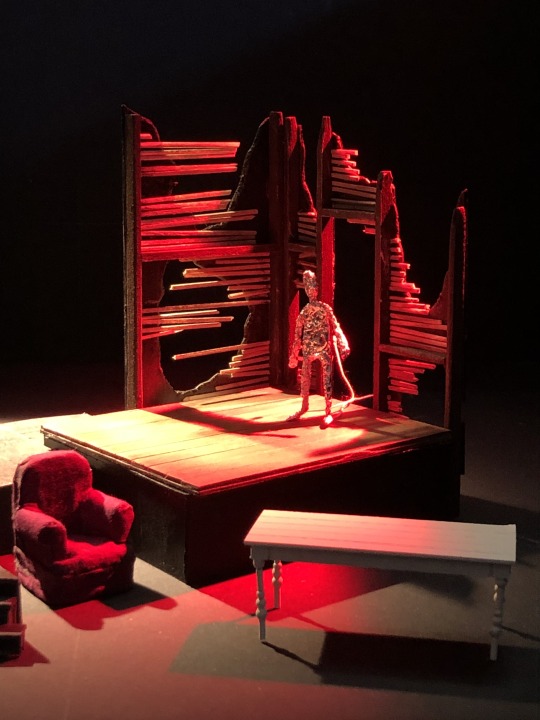
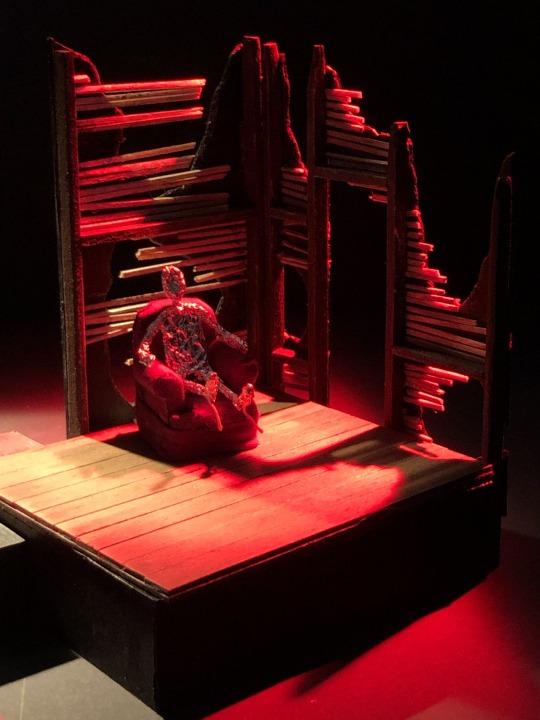
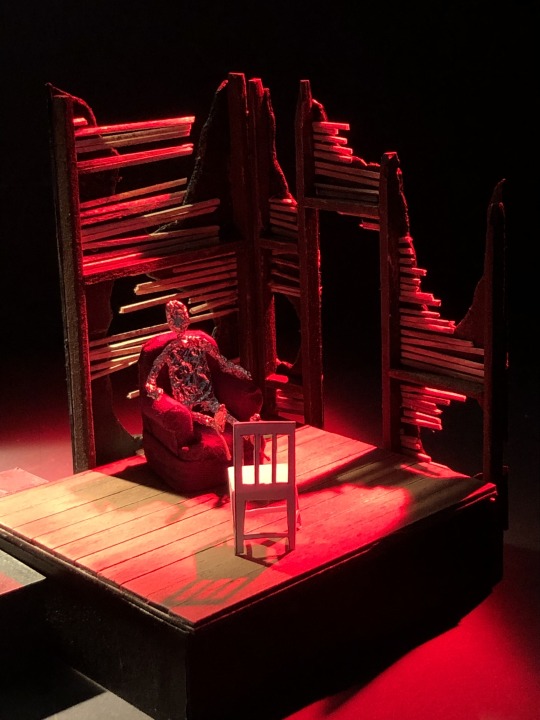
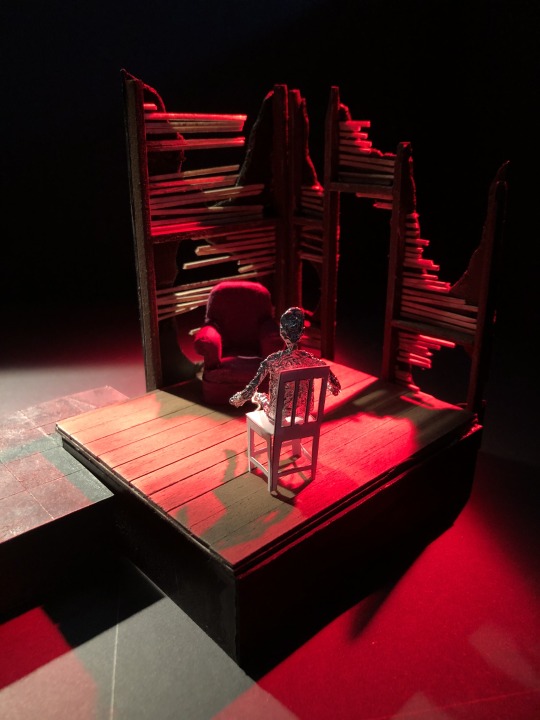
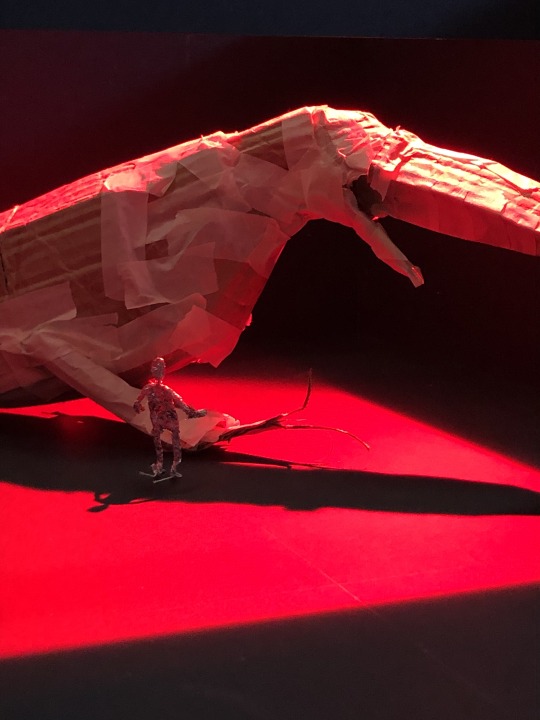

I did a scale model workshop with Lee Cadden, focussing on creating a human figure 1/25th my size. It is made up of a wire armature wrapped in tin foil to allow it to show up on camera. As I was making it, I created a character in my head and it ended up being an old man, shown fully in the last photo after I’d made a walking stick out of a spare piece of wire. This helped me when positioning it for the photos, establishing a narrative out of the miniature set pieces.
I used yellow/white and red lights to follow the blood-like colour scheme of my work, and the colours of the set pieces worked harmoniously with this. I wanted the photos to explore isolation and loneliness, with the two chairs suggesting that another figure should be present. I hadn’t really played with narrative in my work in this way, and it was interesting to experiment with.
I also did a 3D model workshop, forming a bird out of cardboard and tape. I decided to elongate the body and bird to create a mutated, dramatic shape, which I thought would create some interesting shadows in the photos. Unfortunately many of my photos with both the scale model and 3D model came out blurry, however I think the photo I used shows the contrasting scale ad colour experimentation well.
After working with sculpture, I decided to look into the work of Louise Bourgeois, who worked mainly in metal framed sculptures and exploring humanity and emotion through them.
Louise Bourgeois (25th December 1911 - 31st May 2010) was a French-American artist most notably known for her sculptural work and installations. Her work explores many themes, including family, sexuality and death, all of which connect to her childhood, allowing her work to become a therapeutic process. The New York Times stated that her work “shared a set of repeated themes, centred on the human body and its need for nurture and protection in a frightening world.”
Bourgeois was born in Paris to Josephine Fauriaux and Louis Bourgeois, owner of a gallery which dealt mainly in antique tapestries. They moved out of the city to Choisy-le-Roi a few years after her birth to set up a workshop for tapestry restoration, surrounding Bourgeois with art from an early age.
Her mother, who she was particularly close with, died in 1932, prompting her to quit studying mathematics at the Sorbonne after two years there, although Bourgeois stated “I got peace of mind, only through the study of rules nobody could change,” in relation to maths and geometry. Her mothers death was especially impactful on Bourgeois due to her fathers continued affairs throughout her sickness and eventual end, including one lasting ten years with his daughters live in English tutor, with the theme of anger towards her father appearing often in her work. Her mother also is featured in her sculptures through the motif of a spider. Bourgeois said, “the spider is an ode to my mother [...] she was my best friend. Like a spider, my mother was a weaver [...] Like spiders, my mother was very clever.” The spider represents women, and although at first seeming off-putting and frightening, in fact act as protectors, conveying strength and power.
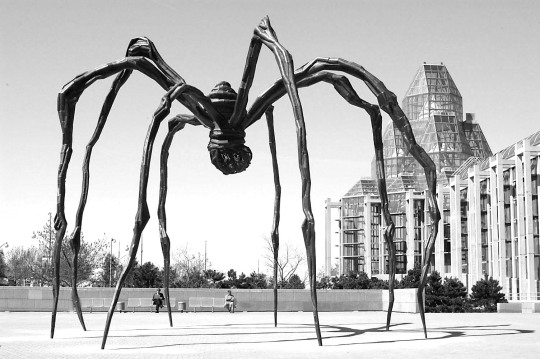
‘Maman’, 1999, Louise Bourgeois
After her mothers death she began studying art, joining classes as a translator for English speaking students as this meant she was not charged tuition. Alongside this, she got a job leading tours at the Musee de Louvre, surrounding her with art both in school and at work. After graduating from the Sorbonne, Bourgeois studied art further at the Ecole de Beaux-Arts and Ecole du Louvre. She opened a print shop next to her father’s tapestry gallery, where she met American art professor and critic Robert Goldwater, who she married and had three sons with. In 1932 she moved with Goldwater to New York City, continuing schooling at the Art Students League of New York where she studied painting under Vaclav Vytlacil, a notable abstract painter. About painting, Bourgeois said, “The first painting has a grid: the grid is a very peaceful thing because nothing can go wrong ... everything is complete. There is no room for anxiety ... everything has a place, everything is welcome.”
This introduces another prominent theme in Bourgeois’ life and work: anxiety. Jerry Gorovoy, her assistant and friend, stated “she was very anxious - a trait she thought she inherited from her mother.” This anxiety can be seen in her 1993 piece, ‘Arch of Hysteria’.
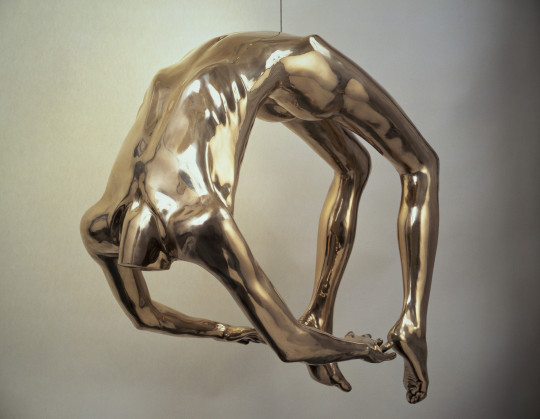
Bourgeois had been in psychoanalysis from 1951 until the 1980s following the death of her father and depression that came alongside it. She started therapy with Dr Leonard Cammer, although switched to Dr Henry Lowenfeld the next year, a student of Sigmund Freud. There was a huge focus on hysteria in Freudian psychoanalysis, particularly that involving women. Within these fits, the women would contort their bodies into arches, although there is no physical reason for this reaction. Frediuans thought it to be a psycho-sexual reaction or one of the unlocking of repressed memories, and Bourgeois’ work explores a similar theme, with her sculptural work unlocking the psychological and emotional memories within her body. The sculpture was cast from Gorovoy’s body, then hung from the ceiling to reflect the fragility and vulnerability of humans. It could turn and spin, preventing it fro being in a stable condition, much like the psyche. Bourgeois made it highly polished so that the viewer could see their reflection on the body, connection them to the piece and introducing questions about the self upon view.
In 2012 her work was exhibited in The Freud Museum London in ‘Louis Bourgeois: Return of the Repressed’. It came about after Gorovoy discovered two boxes of her writings containing over one thousand sheets recording her psychoanalysis and meetings with Lowenfeld. these writings provide the viewer with an insight into both her state of mind and working process. The curator, Phillip Larratt-Smith said, “the discovery of the psychoanalytic writings has enriched and augmented our understanding of Bourgeois’ work and life immeasurably. They represent a distinct contribution to art history as well as to the field of psychoanalysis.” Despite this, Bourgeois felt that psychoanalysis could not help her - “The truth is that Freud did nothing for artists, or for the artist’s problem, the artist’s torment,” “to be an artist involves some suffering. That's why artists repeat themselves - because they have no access to a cure.” Even Freud himself admitted “before the problem of the creative artist, psychoanalysis must lay down its arms,” in his 1926 essay ‘Dostoevesky and Parricide’.
Upon researching Bourgeois I found myself entirely consumed by her life story, with my reading spanning multiple days. She fascinates me, and her perspective of involving personal traumas and memories within her work resonates with me, although perhaps less notably in this project. Despite not being a huge fan of all of her work, her creative process is one that will stick with me and somewhat mirrors that of my own work. I like to confront my own issues through art as a way of coping with them. It is entirely personal and means I can express these concerns without any judgement other than that of myself. This has been extremely healing and in my opinion, one of the most beneficial aspects of being a creative.
Reference links:
https://whitehotmagazine.com/articles/louise-bourgeois-at-freud-museum/2547
https://www.theguardian.com/artanddesign/2012/apr/06/louise-bourgeois-freud
https://www.theguardian.com/lifeandstyle/2016/mar/14/louise-bourgeois-feminist-art-sculptor-bilbao-guggenheim-women
https://www.youtube.com/watch?v=AbXpUr3bZmI
0 notes
Text
How a young photographer puts modern Mongolia in focus
New Post has been published on http://khalilhumam.com/how-a-young-photographer-puts-modern-mongolia-in-focus/
How a young photographer puts modern Mongolia in focus
Men wear Khadags as blindfolds. The Khadag (Katak in Tibetan) is a ceremonial silk scarf symbolising purity and compassion which Buddhists offer as gifts during important ceremonies such as births, funerals, and weddings. Photo (c): Kush Zorigt, used with permission.
Contemporary art isn't the first thing which comes to mind when one thinks of Mongolia. Nevertheless, today the country has its own vibrant gallery scene. Mongolian artists are exploring modern art, fashion, literature, and visual arts from around the world, sometimes mixing them with their own traditional art forms. Most of these contemporary artists are based in the capital city of Ulaanbaatar, which is home to half of the population of this vast country of three million. Ulaanbaatar is known for its outlying districts where traditional ger [the Mongolian yurt] tents cluster together on the edge of the steppe, their inhabitants attracted by a newfound wealth largely driven by the mining industry. But Ulaanbaatar's rapid growth has also led to new social divides, alongside dangerous levels of pollution for which the capital has become notorious. This commercial boom has also given birth to an ultra-modern urban landscape no different from those of Seoul, Tokyo, or Beijing. This is precisely what the Mongolian photographer Kush Zorigt aims to capture in his photos which document the urban landscape, the urban experience, and those who inhabit it. The interview has been edited for brevity.
Kush Zorigt. Photo (c): Blgunee Hiroshi, used with permission.
Filip Noubel (FN): You are a multi-talented artist who started out as a traditional musician, then a jazz musician and singer, then a journalist and now a photographer. Why have you chosen photography?
Kush Zorigt (KZ): I am on a journey of self-exploration. I found photography to be much closer to myself. I was not a visual person initially, I wasn't drawn to films or photography and had little knowledge when studying music. I did explore a new genre with jazz, but I grew up in a traditional family: my parents are professors of classical Mongolian music, my younger brother is a composer, and I was trained for years to play the morin khuur, our traditional stringed instrument. When I started working as a journalist, I was was interested in covering the arts, so about six years ago, I interviewed people working in fashion. Three years ago, I moved to another media outlet, working on photo essays as an editor, and part of my job involved hiring photographers. This is when I realised the impact of visual art. So two and a half years ago I bought a camera, trained myself, and last year I started thinking about storytelling with photos.
FN: Your current exhibition in Ulaanbaatar at the Red Ger Creative Space explores the themes of winter and urban pollution. Could you describe your relationship to the city?
KZ: I wanted to focus on three things with this photo essay in five parts, which was inspired by the music of the contemporary German-British composer Max Richter. The first is beauty: I want to seek out beauty in the city throughout the year. Except for the short summer, Ulaanbaatar is quite dark, but there is something behind these images of long and cold winters that last four to six months. Winter is interesting because the air is thick, and really really cold, down to minus 40 degrees Celsius sometimes. I wanted to show that light and cold blue that I portray in some of my photos. I want people to feel it. The pollution and chaos is another thing. The pollution comes from the Ger district [most people use coal to survive the winter inside their tents – ed.] around the city and from too many cars. Last year the pollution situation did improve, but the city is still overpopulated, which is something we have gotten used to and now see as normal. Thus that's something we somehow fail to see, so I want to portray that as well. I made a conscious choice of excluding the Ger district, because it has its own narrative, and I want to to tell another story about this city. The more time passes, the closer the city becomes for me.
Read more: For LGBTQ+ people in Mongolia, stigma is a fact of life
This woman in Ulaanbaatar wears a mask not because of COVID-19 but because of extreme pollution. Photo: (c) Kush Zorigt, used with permission.
FN: An important part of your photo work, also visible on your Instagram account, is about the body and gender identity. Can you tell us more about this work and the way it's perceived in Mongolia?
KZ: Queerness is not something I can articulate well in words, it is much easier to do in pictures. For me they are a more natural way of describing it. I am indeed more interested in portraying male bodies and portraits. In the photoessay called Spring, there is an expression of queerness: there are five young, vulnerable, pure, blooming young men who are also blind [they are blindfolded in the photos – ed.] and hidden. They don't know they are blooming, which is a reference to my personal story of hiding and showing. I also work as a fitness trainer: I wanted to have this type of body, so I trained for 10 years, then studied to become a personal trainer. I also want to have a professional and scientific approach to this line of work. But I noticed that people are intimidated by overall masculine photos, which is a feeling I share. So I thought of giving a different image of health and fitness, something much friendlier. So my photos I use to promote my work as a fitness trainer are also much more on the artistic side.
FN: The general perception from the outside is that Mongolia is an isolated country, squeezed between two giants, Russia and China. How does this location influence the development of contemporary art, whether visual, performance or other forms?
KZ: We shared a lot with China until the early 20th century, in our culture, music, architecture, and history. From our 1921 independence to the 1990 democratic revolution, we lived under a strongly Soviet-style system with a clear ideology, but it helped us advance in [western] classical music. Those two neighbours certainly impacted us culturally. Now we have had a 30 year period of democracy in which we are still trying to define our cultural identity. Today we have jazz which attracts international performers and researchers alike. It's something very new. We have photography classes. But photography as an urban art is very new: most Mongolian professionals are landscape, wedding, or fashion photographers. Now we have a new wave [in photography] thanks to Instagram, so if you check the hashtags of #instameetulaanbaatar or #ubeveryday, you will see a lot of photos. This is why I want to focus on artistic photography. Last year I worked on a short film, and I want to focus on urban stories, on world citizenship, and hope to show my work outside Mongolia too.
Follow Kush Zorigt's Instagram account here
Written by Filip Noubel
0 notes
Photo
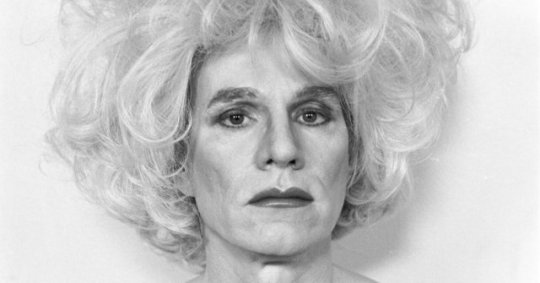
New Post has been published on https://toldnews.com/lifestyle/things-editors-like-t-suggests-cameos-by-cindy-sherman-warhols-portraits-of-women-and-more/
Things Editors Like: T Suggests: Cameos by Cindy Sherman, Warhol’s Portraits of Women and More

Lina Bo Bardi’s Most Beloved Pieces Come to New York
The multidisciplinary Italian-Brazilian artist Lina Bo Bardi is best known as an architect, most famously of the 1968 São Paulo Museum of Art (MASP), a rectangular glass box suspended from two red concrete beams like a kind of Brutalist crab. But she also made radical Modernist furniture. In 1948, not long after she moved to São Paulo from her native Italy, where she had collaborated with architects including Gio Ponti and Carlo Pagani, she founded a furniture studio, Estúdio de Arte e Arquitetura Palma, with fellow Italian architect Giancarlo Palanti. Independently, she continued to create innovative seating and display units for the buildings she designed; in keeping with her communist principles, she liked to shape each aspect of her buildings to encourage accessibility and, in her words, to “fight against the formulaic and routine.”
Among her most influential pieces are the foldable jacaranda-wood chairs she produced for the auditorium at MASP, each of which features an elegant pale leather seat and back that lace up like corsets. One such chair is now on view at a new exhibition, “Lina Bo Bardi & Giancarlo Palanti: Studio d’Arte Palma,” of rare Bo Bardi furniture at Gladstone 64 gallery in New York. Also on display are a swooping iron-and-leather deck chair she created for Casa Valéria Cirell, the rustic shingle-walled home she built for a professor and his family in a tropical suburb of São Paulo in 1964, a mahogany Zig-Zag armchair with a fuzzy animal-hide seat by Estúdio de Arte e Arquitetura Palma and a compact movable wooden chair she designed for the Espírito Santo do Cerrado Church in southeastern Brazil.
Complementing the furniture are works by Bo Bardi’s contemporaries in the Brazilian artists’ collective Grupo Frente, including Lygia Clark and Alfredo Volpi. For Simone Battisti, a partner at Gladstone, the exhibition is all the more exciting because of its setting; the gallery occupies the former home of another Modernist architect, Edward Durell Stone, who in 1956 replaced the facade of the classic Upper East Side brownstone with a geometric concrete grid. His neighbors at the time weren’t pleased, which I imagine Bo Bardi would have enjoyed. On view through June 15 at Gladstone 64, 130 East 64th Street, New York, gladstone64.com — ALICE NEWELL-HANSON
Photographers Take on a New Medium: Cameo
According to the Egyptologist and philologist E.A. Wallis Budge, the word “cameo” derives from the Cabalist word Kame’a, meaning “magical square.” Magic certainly comes to mind when viewing the enchanting new cameos created by the photographers Cindy Sherman and Catherine Opie, who worked with the New York-based collector Liz Swig on a new limited-edition series called “Cameo.” The project consists of nine jewelry pieces — four by Sherman and five by Opie — that will be shown at the Venice Biennale this May and will be available for sale online. The latest project from LizWorks, a platform founded in 2014 by Swig to foster creative collaboration, “Cameo” began after Swig saw Opie’s 2017 exhibition “Portraits and Landscapes” at London’s Thomas Dane Gallery, which included a series of portraits with dark oval backdrops. The photographs reminded Swig of one of the oldest forms of portraiture: the carved cameo. “I was like, ‘Wait a minute!’ Swig says. “Nobody has explored the cameo, maybe ever, in contemporary dialogue and life.”
Soon after, Swig reached out to Opie and Sherman about carving their photographs into curved shells to create unique cameos. For Opie, the project with LizWorks gave her the opportunity to put the art form, which dates back to ancient Greece, in a new context. “When I make a photograph, there’s only five of them out in the world, and I love that there’s this reiteration, or reinterpretation, of a photograph that is not on a gallery or museum or collector’s wall but that it’s out in the world being worn,” she says. Sherman’s cameos transport the most contemporary form of portraiture from the digital into the tangible. She tells T in an email that she had “been looking for alternative ways to transform some of my images from Instagram, since they’re not suitable for regular photographic reproduction. And I like the idea of jewelry as art.”
The cameos were carved by the artisan Gino de Luca, whom Swig met at a jewelry fair in Vicenza, Italy. De Luca is a descendant of a long line of cameo-makers based in Torre del Greco, a town outside of Naples where cameos have been made for centuries. “Cameo” was de Luca’s first encounter with the works of Sherman and Opie, and a chance to modernize his family’s craft. “Within a minute, he just got it,” Swig says of speaking to De Luca about her vision. “He is a magic force, but on this earth.” Price on request, lizworks.net — HILARY REID
A Show on Andy Warhol’s Favorite Subject: Women
In the wake of the Whitney’s landmark Andy Warhol retrospective, “From A to B and Back Again” — the first show of its kind at a U.S. museum in 30 years — New York’s galleries are taking a turn celebrating the artist in their own ways. Sperone Westwater is exhibiting a collection of the artist’s early drawings of people and still lifes of food, handbags and stilettos while, at its upstate satellite in Kinderhook, Jack Shainman will soon open a show of the collaborative paintings Warhol did with Jean-Michel Basquiat. Up at Lévy Gorvy is “Warhol Women,” which, along with some of Warhol’s best-known portraits (Jackie, Marilyn), includes those of Gertrude Stein, Golda Meir and the artist’s mother, Julia Warhola. “It’s such an obvious subject,” says the writer Alison Gingeras, who will contribute an essay to the show’s catalog, of Warhol’s relationship to and reliance on women, “and yet it’s never been fully unpacked in all its complexity.”
That complexity is perhaps most apparent in four images near the gallery’s entrance that a casual observer might dismiss, unwisely, as outliers: These photos, taken over two days in 1981 by Christopher Makos, are of the artist himself in coifed wigs and full makeup. In one, Warhol has been rendered almost unrecognizable, with teased-up Stevie Nicks hair, drawn-on eyebrows and a flirty pose incorporating clasped hands. In another, he channels his most famous subject with an asymmetrical blond wig, a bent knee and arms crossed modestly over his crotch. Though rather than a billowing dress, he wears slim jeans, a white button-up and a plaid tie, as if, below the neck, he’s still Andy. Warhol was deeply fascinated by New York’s drag culture. As far back as the 1950s, he attended clandestine drag salons hosted by the photographer Otto Fenn and made drawings (some of them part of the Sperone Westwater show) based on Fenn’s images. Still, Makos has said that’s not quite what these pictures are about. As Gingeras puts it, “They’re more about undoing gender than performing drag,” adding, “Warhol had an expansive definition of what a woman is.” “Warhol Women,” through June 15 at Lévy Gorvy, 909 Madison Avenue, New York, levygorvy.com — MERRELL HAMBLETON
From Bobbi Jene Smith, a Dance Work Like a Mountain
Since leaving Tel Aviv, where she was a principal with Batsheva Dance Company, in 2014, the Iowa-born Bobbi Jene Smith has been busy choreographing or appearing in one work after another. “With Care,” an elegiac follow-up to her solo “A Study on Effort,” debuted in the fall, and “Deo,” a dramatic staging of the myth of Demeter and Persephone, which Smith cocreated with Maxine Doyle for the Martha Graham Dance Company, premiered last month. But even as she embodies Graham’s definition of the artist as someone who just keeps marching, Smith isn’t much interested in straight, continuous lines. “It’s creation and destruction. You build up and then have to come down, or go down to come up,” she says of her process. Indeed, the symbol of the mountain has become something of a touchstone for her, one that’s directly informed her newest piece, “Lost Mountain,” which will open in New York at La MaMa the weekend of May 16.
In this case, the mountain is not just a metaphor for the artistic struggle but also for the search for meaning in life. To Smith’s mind, one way that meaning can be found is through moments of human connection. “I like the idea of people bumping into each other and, much like the tectonic forces that make the mountain itself, rising up to make something larger,” she says. She will perform the piece with an ensemble of 10 that includes the dancer-choreographer Marta Miller (“I’m pulling her out of retirement for this”); Or Schraiber, Smith’s husband; the violinist Keir GoGwilt; and the Israeli singer-songwriter Asaf Avidan. When we speak, Smith is hesitant to give away too many details but shares that the evening-length work consists of a series of cinematic vignettes, that all of the music will be live and that there will be little separation between art forms. Fittingly, the group is rehearsing at a farmhouse-turned-artist-retreat on a mountain in southern Vermont. Have there been any inspirational hikes, one wonders? “Hopefully next week. It’s been pretty cold,” says Smith. “And we have a lot of work to do.” “Lost Mountain” will open as part of La MaMa’s Moves! Dance Festival on May 16, at the Ellen Stewart Theatre, 66 East Fourth Street, New York, lamama.org — KATE GUADAGNINO
Michelle Pfeiffer’s Intoxicating New Scents
The last person I’d expect to create a collection of slightly hallucinogenic abstract contemporary art might be Michelle Pfeiffer. But the perfumes from her new collection, Henry Rose, range from the delightfully disorienting (like a Jeff Koons balloon dog) to the unsettling, like a Spielbergian poltergeist-filled TV screen.
Last Light, one of the five scents, is somehow at once lovely and hopelessly unreachable. Jake’s House is a fresh eau de cologne but smells like it was made in 2042, and so is simultaneously familiar and alarming. Fog is a work of conceptual realism — a shadowy curtain of scent that silently curls around you. (The catch, of course, is that fog has no smell. That makes it an olfactory illusion, an extraordinary trick and a mesmerizing perfume.)
Dark Is Night smells like you’re in a nightclub — you know, nightclub air at 2 a.m.: the scent of aluminum, electricity and perfume with a hint of dark plums drenched in sugared rum. You’re lost; having this many weird olfactory landmarks means you have none. The parts fly at you, fill you up till suddenly. You can’t pass a mental breathalyzer. henryrose.com — CHANDLER BURR
#lifestyle disease news#lifestyle news english#lifestyle news indian express#lifestyle news shows#lifestyle news.com#pembury lifestyle group news
0 notes
Text
Hyperallergic: The Eclectic Objects that Inspired Matisse’s Art
Henri Cartier-Bresson, “Matisse with his collection of Kuba cloths and a Samoan tapa on the wall behind him, Villa La Rêve, Vence” (1944) (© Henri Cartier-Bresson/Magnum Photos, image courtesy Museum of Fine Arts, Boston)
BOSTON — In 1944, Henri Cartier-Bresson photographed Henri Matisse in his studio surrounded by curious objects: a pewter jug with a swirling design, a Samoan tapa, Chinese porcelain, Kuba cloths, seashells, a bird cage, and a 14th-century head carved from stone. Obviously Matisse loved beautiful, well-designed objects and had collected more than 200 by his death in 1954. In his mind, they were neither decorative baubles nor travel trophies. Rather, they served him as visual references that opened his mind to new possibilities in seeing and creating.
Matisse in the Studio, at the Museum of Fine Arts, Boston, is the first exhibit to focus specifically on Matisse’s objects and how they influenced his art making. Thirty-nine are paired with the paintings, drawings, bronzes, and cut-outs they either influenced or appeared in.
Vase, artist unknown, Andalusia, Spain (early 20th century), blown glass (Ancienne collection Henri Matisse, former collection of Henri Matisse, Musée Matisse, Nice. Bequest of Madame Henri Matisse, 1960. Photo by François Fernandez, image courtesy Musée Matisse / Museum of Fine Arts, Boston)
“Our exhibition is exciting because it allows you to almost step inside the space of the studio and see some of the actual materials that Matisse was looking at and he was inspired by,” said Ellen McBreen, associate professor of art history at Wheaton College and Matisse scholar. She co-curated this exhibit with Helen Burnham, the Pamela and Peter Voss curator of prints and drawings at the MFA, and Ann Dumas, curator of the Royal Academy of Arts in London, where the show will travel to next.
Early in his career, Matisse sought new ways to represent one of his lifelong passions, the human nude form. He said, it “permits me to express my almost religious awe towards life.” Thus, it’s fitting this exhibit opens with Bresson’s photo and an anthropomorphic turquoise vase Matisse found on his 1910 trip to Andalusia. No doubt the artist took pleasure in the vase’s sinuous curves, half-moon handles, and bulbous hips that bring to mind a stoutly woman. It is the central figure in his painting “Vase of Flowers” (1924).
Perhaps the vase liberated Matisse from his academic art training, which required him to draw models exactly as he saw them. He knew the era of straight-on figure representation was over. He had seen the 1901 Vincent van Gogh retrospective at Galerie Bernheim-Jeune and followed Picasso and Braque as they explored Cubism. While he wanted to abstract the human form, he wanted to do it in a simpler, more natural way.
Henri Matisse, “Vase of Flowers” (1924), oil on canvas (bequest of John T. Spaulding, © 2011 Succession H. Matisse, Paris / Artists Rights Society (ARS),
New York) * Photograph © Museum of Fine Arts, Boston
On his way to Gertrude Stein’s house in 1906, he stopped in a little Parisian junk shop and purchased a hand-carved wooden Vili figure, a tourist reproduction of those used in Congolese healing and fertility rites. He and Picasso were both drawn to its expressive language. That carving appears in Matisse’s 1907 painting “Still Life with African Statuette,” and, for the first time, the painting and object are displayed together.
In 1912, painter Clara T. MacChesney interviewed Matisse for an article in New York Times Magazine, and asked him, “What is your theory on art?” He replied by pointing to a table with a jar of nasturtiums. He said, “I do not paint that table, but the emotion it produces upon me.”
Over the next couple of years, Matisse would purchase 20 masks and figurines made in Northern and Central Africa. He took a cruder and more direct approach in depicting nudes, as seen in “Young Women,” a bronze from 1907-08. Critics reacted harshly to it and similar works, saying that Matisse strained in his abstraction and these works were “ugly” and the colors “cruel.”
Matisse in the Studio installation view at the Museum of Fine Arts, Boston, Ann and Graham Gund Gallery (photograph © Museum of Fine Arts, Boston)
Matisse noted that some African works depicted the human form as genderless or possessing both female and male characteristics. Thus, he decided to apply this idea in the bronze “Young Women.” From one angle, the two figures appear to be women embracing. From another angle, one figure rises a bit taller and has a more wide-legged stance and mannish appearance.
“Why?” MacChesney asked Matisse during their interview, when she spotted a lumpy and crudely formed female figure, from this same generation of sculptures. Matisse reached for a Javanese statue with a disproportionately large head and asked, “Is not that beautiful?” She thought not. Likely he was being coy with her, knowing she didn’t see the human body could be beautiful and expressive without being classically rendered.
Henri Matisse, “Marguerite” (1906–1907), oil on canvas (on loan from the National Musée Picasso, Paris
RF 1973‑33, donation Picasso, © Succession H. Matisse / Artists Rights Society (ARS), New York, photo © RMN-Grand Palais / Art Resource, New York, image courtesy, Museum of Fine Arts, Boston)
The tribal sculptures also inspired Matisse to reinterpret portraits. In painting his 13-year-old daughter, “Marguerite” (1906-07), he wanted to evoke the emotions of innocence and childhood. So he created her portrait with the simplicity of a child’s painting with flattened features, minimal details, and even what seems like a mistake — a profile nose on a frontal face. Even the letters of Marguerite’s name across the top are scrawled as though an inexperienced hand drew them.
Yet the face looks more like a woman’s, and Matisse knew very well his daughter was growing up. In the portrait, the girl wears a black velvet choker, which seems to separate her body from her head, as if she’s wearing a mask. Coincidentally, when Matisse and Picasso decided to trade paintings, Picasso chose this one. He hung it in his studio next to a Punu mask. Perhaps he saw the mask too.
Some accuse the modernists of having culturally pillaged tribal art, while others point out that the African artists and cultures went mostly unattributed. This exhibition, which alludes to but doesn’t explicitly discuss these tensions, aims to put Matisse’s influences front and center.
Window screen (Haiti), artist unknown, North Africa (late 19th‑early 20th century), cotton plain weave cut and appliquéd to bast fiber cloth (former collection of Henri Matisse en dépot, Musée Matisse, Nice. Photo by François Fernandez, image courtesy, Musée Matisse / Museum of Fine Arts, Boston)
Matisse had a lifelong appreciation of fine tapestries, which began during his student days at École Quentin De La Tour, a textile designing school near Belgium. After he’d traveled to Morocco and Spain and saw an exhibit of Islamic art in Munich, he became enamored with Islamic architecture, design, and fabrics. He acquired at least a half-dozen haitis, which are sumptuous, pierced, and appliquéd textiles that often bear a mihrab motif — the arch shapes and latticework found in the niches of mosques.
In “The Moorish Screen” (1921), Matisse places a blue-green haiti in the room’s corner, hiding the juncture where two walls meet. Doing this envelopes the two women, dressed in pale, simple frocks, in a rich collage of patterns and jeweled colors. The eye normally tracks towards human figures, but here it’s drawn to the room’s lively décor where it spins before going towards the women.
Henri Matisse, “The Moorish Screen” (1921), oil on canvas (Philadelphia Museum of Art, bequest of Lisa Norris Elkins, 1950. Image courtesy the Philadelphia Museum of Art, © 2017 Succession H. Matisse / Artists Rights Society (ARS), New York, courtesy, Museum of Fine Arts, Boston)
One of most fascinating connections made in this exhibit comes from a 19th-century wood panel on which four Chinese calligraphy characters are made with quick, lyrical gestures. A 1951 photograph by Philippe Halsman shows Matisse making cut-outs in bed. Above him hangs this calligraphy panel, and below each character hangs one of Matisse’s gestural nude drawings, much like those in his “Acrobat” series. By this point in his life, he worked spontaneously, reducing the human form to a few lines, and showing complete total control over his application of ink.
Searching for source materials, Matisse traveled extensively and gathered works from China, Egypt, Morocco, Java, Tangiers, the Congo, Europe, and elsewhere. He had eclectic tastes and could find beauty and inspiration just as easily in a silver chocolate pot as a disproportionate statuette. Matisse was interested in how other cultures viewed life, thought about gender, and expressed beauty. His abstraction of the figure and borrowing from other cultures may have baffled viewers at the onset, but over time such experiments would become the hallmarks of modernism.
Matisse in the Studio continues at the Museum of Fine Arts (MFA), Boston (465 Huntington Ave, Boston) through July 9.
The post The Eclectic Objects that Inspired Matisse’s Art appeared first on Hyperallergic.
from Hyperallergic http://ift.tt/2r00JXe
via IFTTT
2 notes
·
View notes
Text
REVOLUTION and RESISTANCE – Art Exhibition in Bear River & Annapolis Royal – Flora Doehler
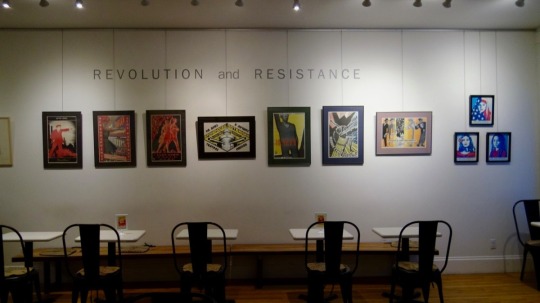
“Every war already carries within it the war which will answer it. Every war is answered by a new war, until everything, everything is smashed… That is why I am so wholeheartedly for a radical end to this madness, and why my only hope is in a world socialism… Pacifism is not a matter of calmly looking on; it is work, hard work.” – Kåthe Kollwitz, 1943.
One day last year, while sipping fair trade coffee at Sissiboo Coffee Cafe with Susan Friend, another Bear River transplant, we learned something new about each other. We both had personal collections of political posters and art about REVOLUTION and RESISTANCE.
Susan had Russian Revolutionary Posters from the 20’s and 30’s and Shepard Fairey posters from the Women’s March on Washington.

Woman at work on loom. This poster depicts a yearly exercise parade of Soviet workers and youth marching together and embracing the ideology of their country. Poster artist not identified
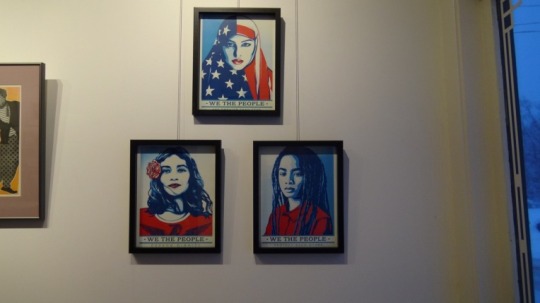
These posters were designed by Shepard Fairey for the Women’s March on Washington, January 21, 2017. It was a stunning show of protest and resistance on the first full day of the Trump administration in the USA.
I treasured my Käthe Kollwitz etchings of the Peasant War (1524) in Europe and the Weaver’s Revolt in Germany (mid 1800’s). Our son had recently mailed us anti war posters from Vietnam where he’s teaching English.
Wouldn’t it be great, we said, if we could share this inspiring, historic art with others. We approached Erin and Jon Welch at Sissiboo Cafe who offered us wall space in both Bear River and Annapolis Royal for our project.
And now it’s happening.

Sissiboo Coffee Bar and Gallery in Bear River, Nova Scotia. Winter hours are Wed, Thurs and Fri 7:30 – 2:30; Sat 9 – 4 from now until the end of February.
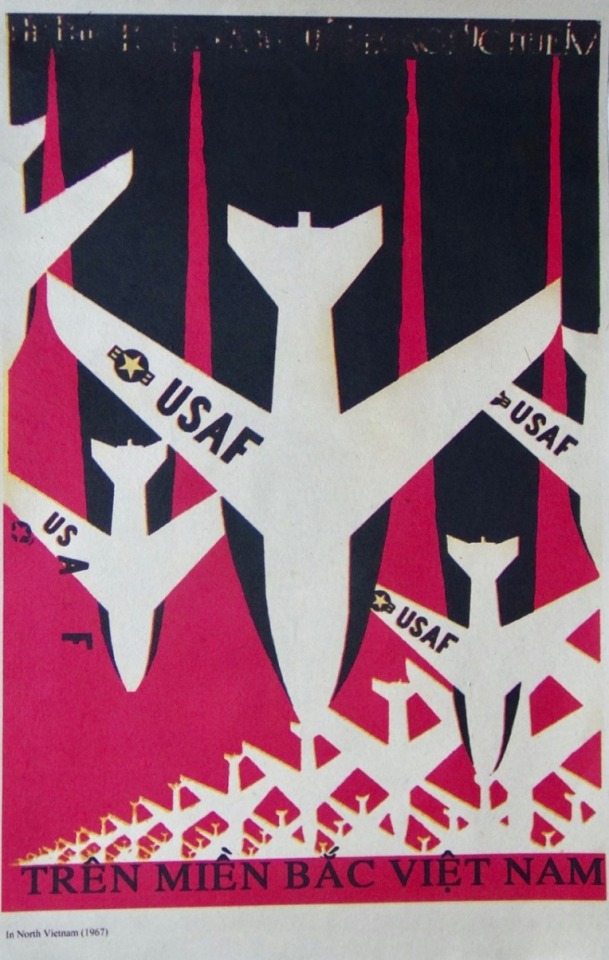
In North Vietnam (1967) By the time the last American combat troops left Vietnam in 1973, the U.S. military had dropped some 4.6 million tons of bombs on Vietnam. This was double the number of bombs dropped in WW2. They destroyed a large percentage of the nation’s towns and villages and killed an estimated 2 million Vietnamese people. Over 50 thousand Americans lost their lives and many more Americans and Vietnamese continue to be affected by their physical and emotional injuries. Reproduction poster on rice paper from The Socialist Republic of Vietnam.
These artworks are significant in many ways:
the art is used to educate, to communicate and to inspire action
even the art style was revolutionary. Russian Constructivism, a type of Modernism, combined shape, colour and photo images for the first time.
Kåthe Kollwitz’s use of etching. even by today’s standards, is technically unsurpassed and was used to show the lives of ordinary people, from their point of view.
Kollwitz connected the similarities between contemporary political struggles, with historical resistance
She established herself in an art world dominated by men. Women were not admitted to art schools. In spite of this she would become an art professor in Berlin until the Nazi’s came to power and fired her.
Kollwitz’s work was so powerful, she was banned by the Nazis from producing, showing or selling her work.
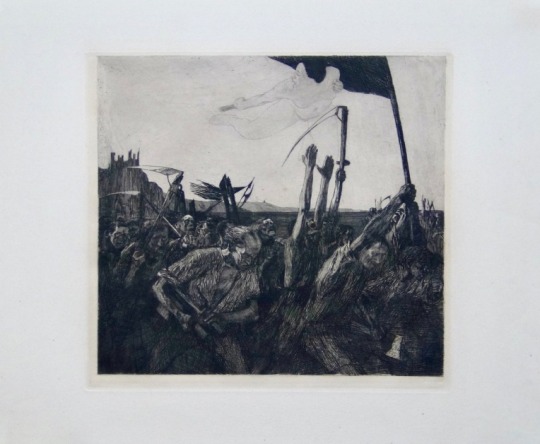
Käthe Kollwitz Title: Aufruhr (Uprising) Medium: Etching Series: The Weavers’ Revolt Year: 1899 In many ways, the Silesian weavers’ revolt was a traditional response to poverty and hunger. However, the weavers’ words and actions indicated a changing understanding of their position in society. Because of this the event has gained enormous significance in the history of the German labor movement Karl Marx regarded the uprising as evidence of the birth of a German workers’ movement.
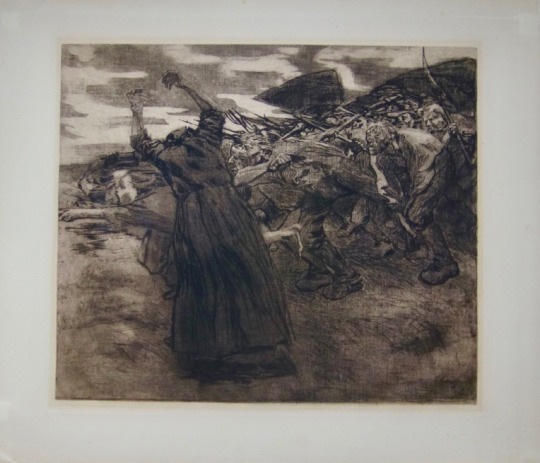
Käthe Kollwitz Title: Losbruch (Charge) Medium: Etching Series: The Peasants War Year: 1903 In many ways, the Silesian weavers’ revolt was a traditional response to poverty and hunger. However, the weavers’ words and actions indicated a changing understanding of their position in society. Because of this the event has gained enormous significance in the history of the German labor movement Karl Marx regarded the uprising as evidence of the birth of a German workers’ movement.
Vietnam’s posters lifted moral during the devastating war invasion by the US in the 60’s-70’s
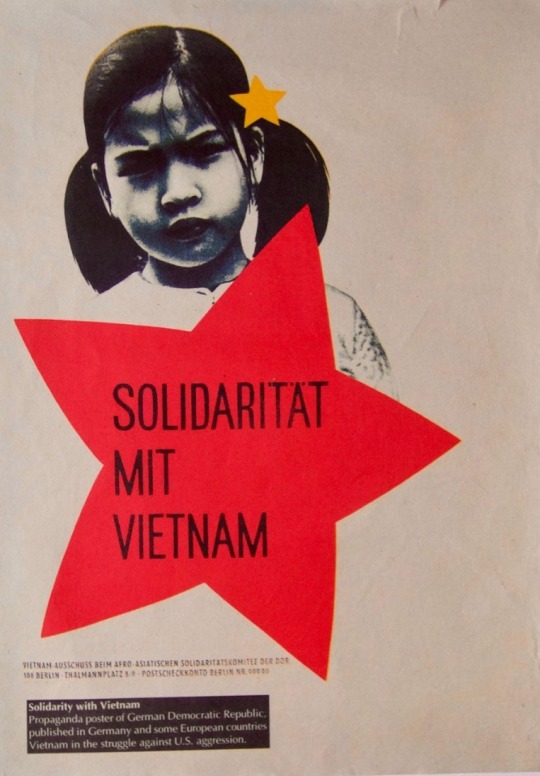
Solidarity with Vietnam (1970) “Vietnam Committee of the Afro-Asian Solidarity Committee of the GDR” (Germany Democratic Republic) All of the socialist countries in Europe, Asia and Cuba offered varying types of support to Vietnam in its war with the US. At war’s end, thousands of young people were invited to socialist countries to attend University for free, in order to rebuild their war-ravaged homeland. Reproduction poster on rice paper from The Socialist Republic of Vietnam.
These artworks give us glimpses into the human struggle for survival. The fight for basic human needs; food, shelter, rights and freedoms.
They also document how a monumental political eruption, born out of desperation can occur, when ordinary people are driven to revolt against the conditions in their country.
The Russian Revolution resulted in the world’s first Communist State. It had enormous global impact. It influenced other countries to follow suit and the world became divided not only by geography but by ideology.
Those political divisions remain today, as does the human struggle against inequality.
This collection of posters, postcards, and original etchings are from the Federal Republic of Germany, the former German Democratic Republic, the former Soviet Union, the Socialist Republic of Vietnam and the United States of America.
We hope you are inspired by its content.

Larry Knox hangs Susan Friend’s Soviet era posters.
Art from the Russian Revolution, Vietnam, Germany, and the USA
Opens Sat Jan 13, 2018, 1 – 3 pm
January – February 28, 2018
Sissiboo Coffee Bar & Gallery, Bear River NS
1890 Clementsvale Rd
Winter hours: Wed, Thurs and Fri 7:30 – 2:30; Sat 9 – 4 until the end of February.
——————————————————————-
Show continues March1 – April 15, 2018
in Annapolis Royal, NS
@ Sissiboo Coffee Bar & Gallery
George Street
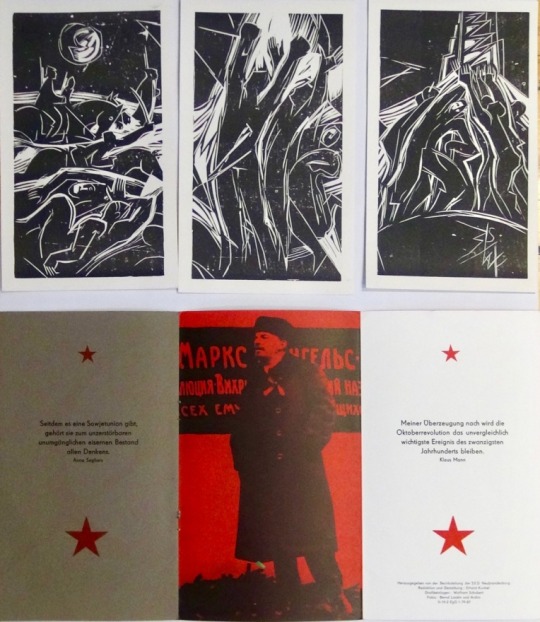
Celebration of the 70th Anniversary of the Great Socialist October Revolution (1987) “Most beautiful, happiest star on earth” The red star is a communist symbol and each of the 5 points represents one of five groups in society. They are the Proletariat, Farmers, Intellectuals, Youth and the Military. This display was a booklet in the German Democratic Republic that marked the anniversary of the Russian Revolution in 1917. The woodcuts were made by artist Wolfram Schubert who was the painting professor of Flora Doehler in Berlin.
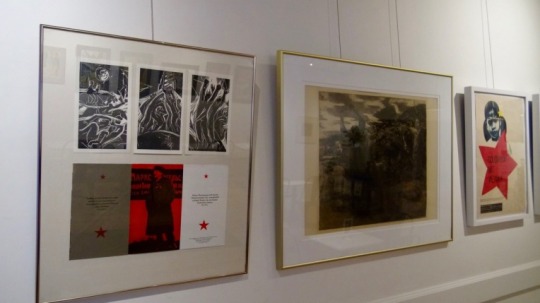
REVOLUTION and RESISTANCE posters and etchings from the 20th century.
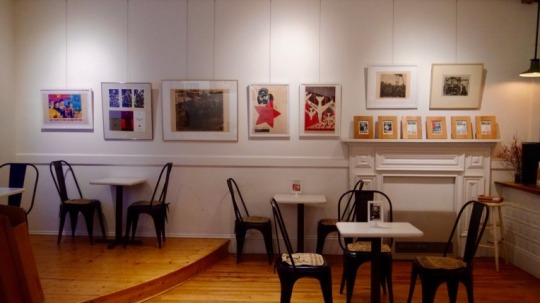
REVOLUTION and RESISTANCE showing at Sissiboo Coffee Bar and Gallery in Bear River January, 2017.

These posters were designed by Shepard Fairey for the Women’s March on Washington, January 21, 2017. It was a stunning show of protest and resistance on the first full day of the Trump administration in the USA.

“The First Time – eyes closed when kissing; eyes open when voting” Election Posters of the PDS: A greeting from the left – where the heart beats (postcard set) The Party of German Socialism descended from the party that had ruled the former German Democratic Republic. It existed from 1989 until 2007 when it joined other left wing groups and became The Linke (The Left)
Source
https://floradoehler.ca/2018/01/12/revolution-and-resistance-art-exhibition-in-bear-river-annapolis-royal/
0 notes